History
Much of the information on this page was taken from the book A Century of Golden Years: The Centennial History of McLean, Illinois by the Centennial Book Committee of the McLean Centennial Association in 1955. Members of this committee were: Elmer Dickerson, Wilbur Taylor, Ora Westerfield, Byron Canfield, Everett Southerlan, Lester Van Hoosier, Wilbur Downs, Garlen Necessary, George Mitchell, and Gearold Davis (chairman). This book, which is a treasure trove of history, photos, reminiscences, and sentiments about the first 100 years of McLean's history (1855–1955), is available at the Mt. Hope–Funks Grove Library (in-house use only) for those who are interested in delving more deeply into the village's history.
Scroll down to see a gallery of images.
If you have any photos or information that you would like to contribute to this page, please use the Contact Us page and select the "Website Comments/Questions" department.
The Founding of the Village of McLean
[Excerpted from A Century of Golden Years: The Centennial History of McLean, Illinois by the Centennial Book Committee of the McLean Centennial Association (1955), pages 7–8. Text in brackets was added by the editor when transcribing the text for this webpage. Minor grammatical and spelling errors have also been corrected from the original.]
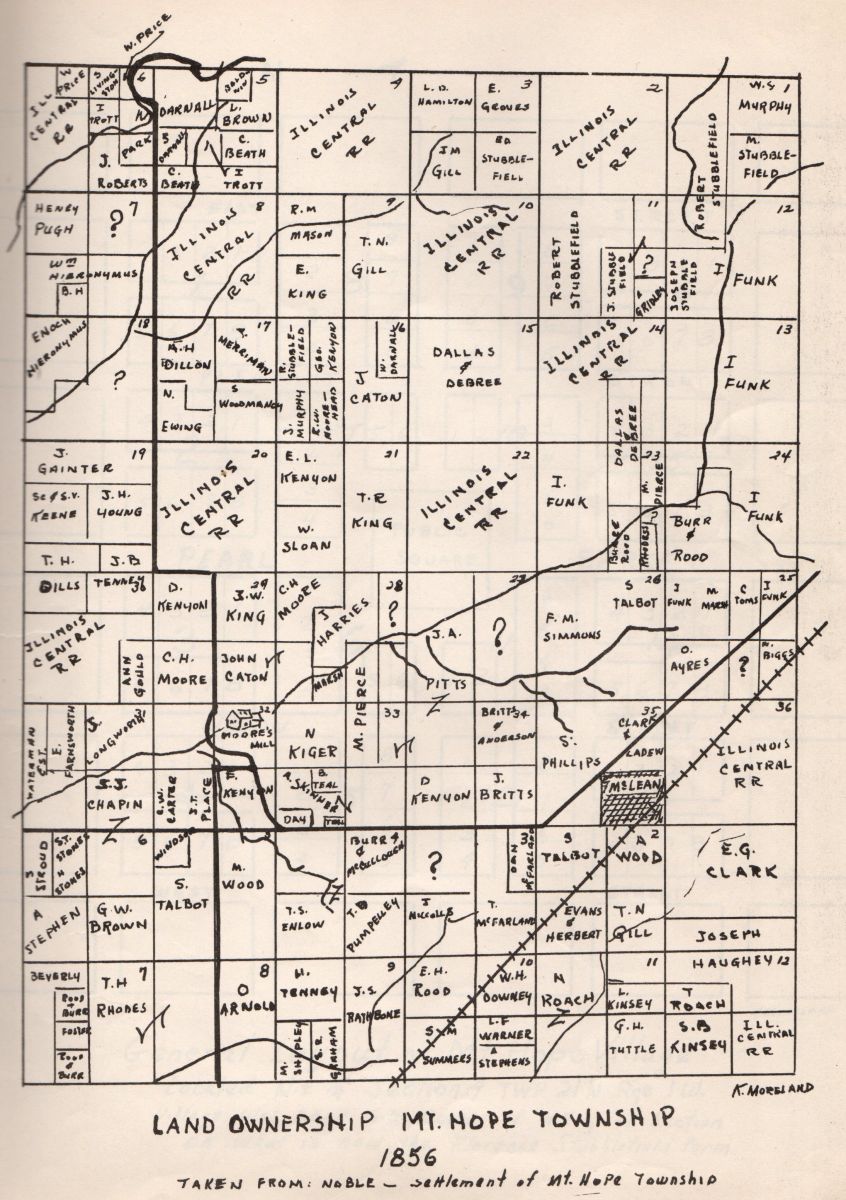 “The land on which the village of McLean stands was originally owned by the old Mount Hope Colony. John C. Cass, the agent in 1852 when the society dissolved, transferred the land to William McCullough of Bloomington. On the first of November 1852, McCullough transferred the tract to Judge David Davis, and on the 10th of January 1855, it was transferred from Davis to Franklin Price. Prior to that time, April 21, 1853, Judge Davis had deeded the C & M Railway a right-of-way through section 35. [See plat. The original village limits are shaded in toward the bottom right of the plat (in section 35).]
“The land on which the village of McLean stands was originally owned by the old Mount Hope Colony. John C. Cass, the agent in 1852 when the society dissolved, transferred the land to William McCullough of Bloomington. On the first of November 1852, McCullough transferred the tract to Judge David Davis, and on the 10th of January 1855, it was transferred from Davis to Franklin Price. Prior to that time, April 21, 1853, Judge Davis had deeded the C & M Railway a right-of-way through section 35. [See plat. The original village limits are shaded in toward the bottom right of the plat (in section 35).]
“Franklin Price laid out the original town of 286 lots in the southeast quarter of section 35. The original survey was made by Peter Folsom June 30, 1855, and the plat and certificate of survey were recorded . . .
“The greater number of the first settlers of McLean were from the East. Among the very first settlers were Lyman B. Goodhue and his wife. Mr. Goodhue was the first postmaster. It is said he carried the mail in his hat and delivered it whenever and wherever he happened to meet the person to whom it was addressed. Before any regular stores were built, he also kept a few groceries and notions.
“G. L. and Caroline Wheelock and their sons Henry G. and C. W. were among the earliest settlers. They were actually in the area about 1854. G. L. was the first railway station agent and for a time lived with his family in the depot. Later he operated the McLean House, which was the first hotel in McLean.
“F. A. Wheelock built the first blacksmith shop in the village. He, however, was not a blacksmith himself, but built the shop to get business started in the village. He later sold the enterprise and building to George A. Glotfelter. Later in 1859, Glotfelter and Harrison Wood started a carriage factory. Several years later this factory was operated by Woods and Stones.
“E. G. Clark, who was a relative of the Wheelocks, settled in the area about the same time as the Wheelocks.
“In the Fall of 1855, A. H. Dillon and Mark Merriam built the first warehouse and started buying grain. Soon after, the Barber Brothers—J. S. and G. P.—erected a warehouse and entered the grain buying business. However, in 1860 they sold their grain business and opened a store on the north side of the town square. (Apparently their warehouse stood near the present [1955] site of the Funks Grove Grain Company.)
“H. W. Wood and John Kellogg came to the village in 1856. Mr. Wood came from Massachusetts and Mr. Kellogg from Tremont. About the same year Dr. F. P. King removed from Menard County to this place and engaged in the mercantile business with Mr. Kellogg.
“William Morrell, grandfather of the present [1955] village mayor [George Morrell], settled in the vicinity about 1856. Others were Edwin M. Oxx, John Hager, and Peter McGuire.
“Shortly after 1860, C. C. Aldrich started buying grain. For storage he rented a small warehouse of Jesse Brock. (This building must have stood in the area east of the present [1955] Town Hall [probably the small white building seen below in 1955 photos of the Village Square, Park St., shared with Dalziel Insurance] and near the railway.) Sometime later, Mr. Aldrich engaged James P. Barber to handle his grain.”

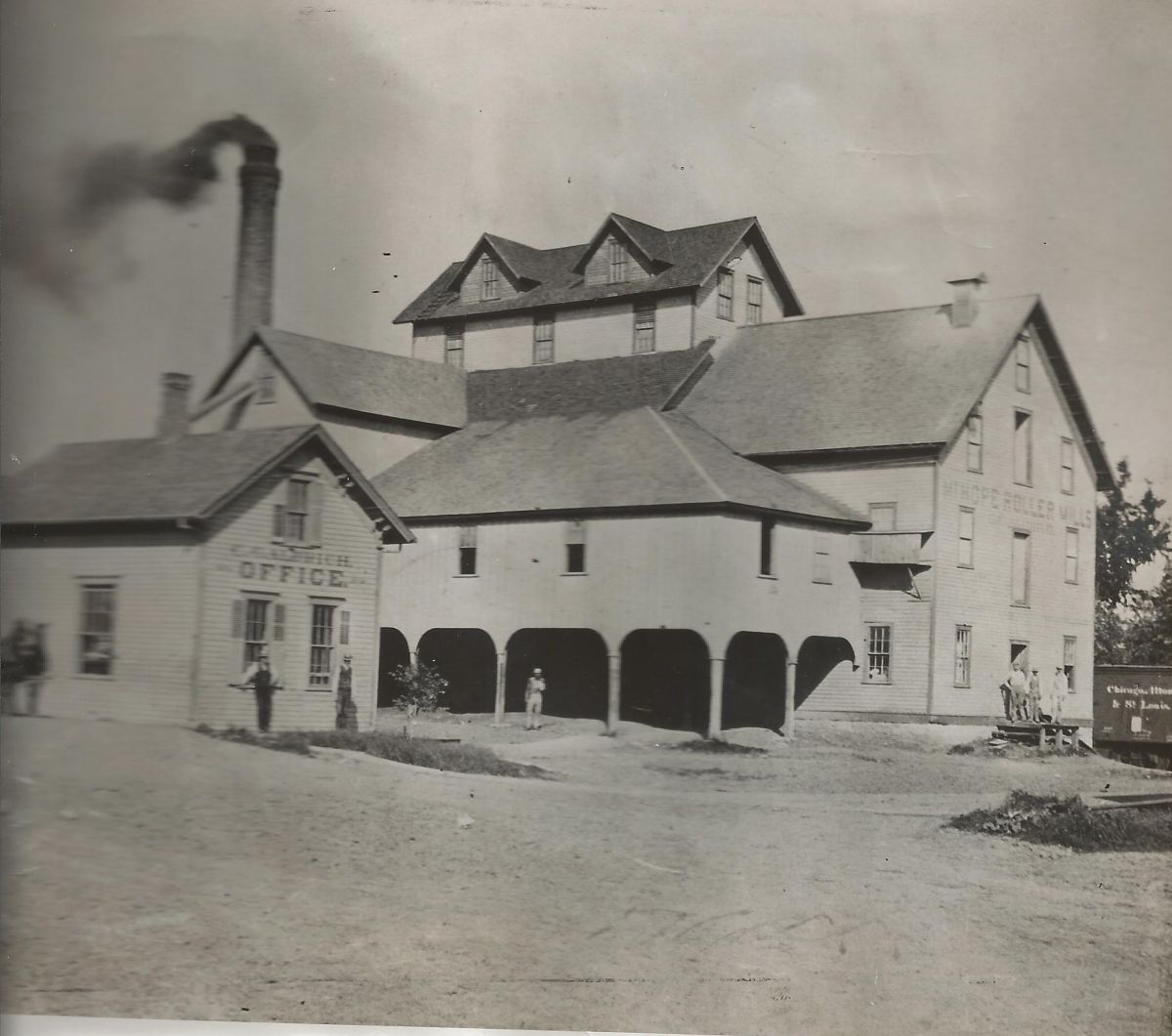 C. C. Aldrich Elevator and Mt. Hope Mills, built in 1868 across the tracks from the McLean Depot (SE corner of village square). Date of photo unknown. The buildings burned down in 1915. Note the Chicago, Alton, & St. Louis train car (far right).
C. C. Aldrich Elevator and Mt. Hope Mills, built in 1868 across the tracks from the McLean Depot (SE corner of village square). Date of photo unknown. The buildings burned down in 1915. Note the Chicago, Alton, & St. Louis train car (far right).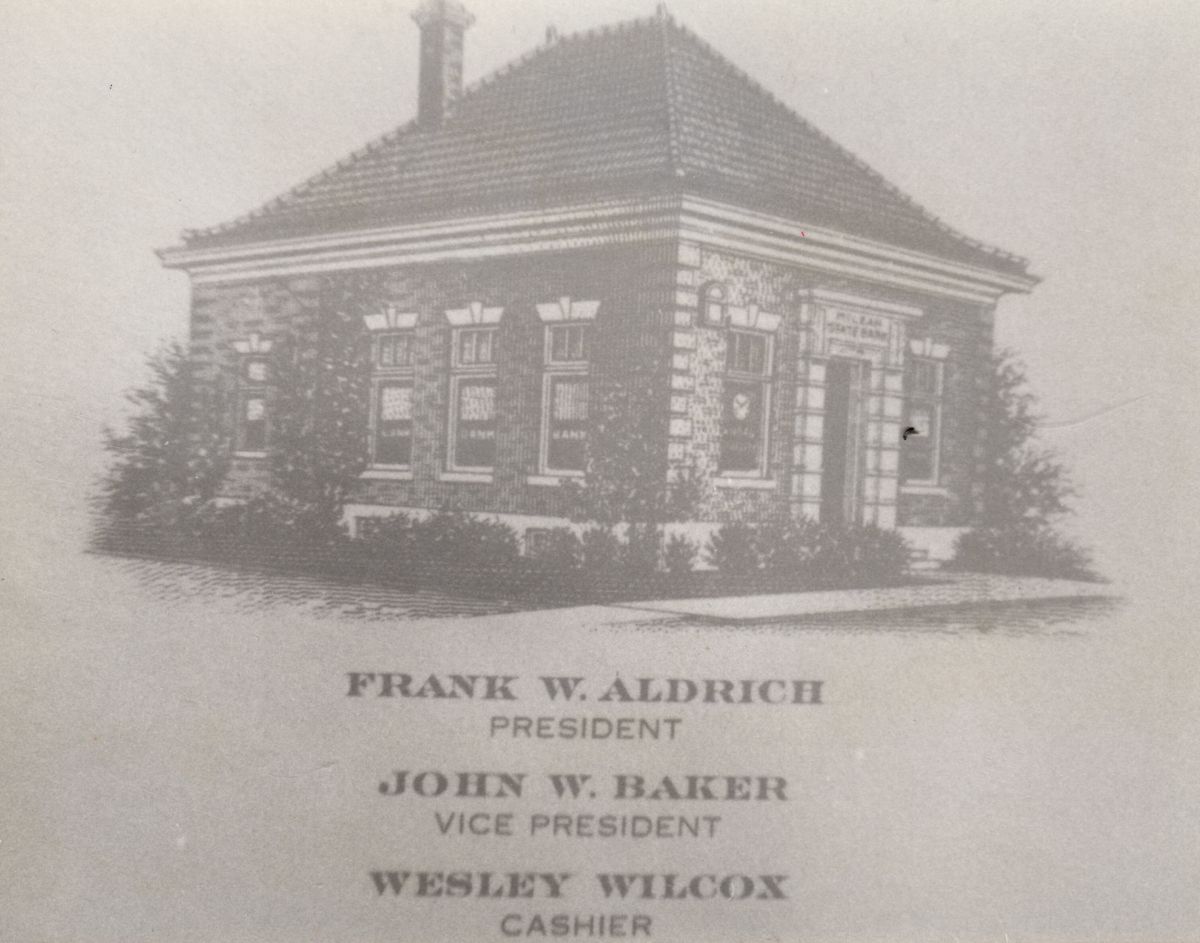 McLean State Bank ad, early 1900s. In 1860 C. C. Aldrich established McLean’s first bank and in 1897 with his son Frank W. formed C. C. Aldrich and Son Bank, which was organized as McLean State Bank in 1906. The bank closed in 1938 when Frank W. retired.
McLean State Bank ad, early 1900s. In 1860 C. C. Aldrich established McLean’s first bank and in 1897 with his son Frank W. formed C. C. Aldrich and Son Bank, which was organized as McLean State Bank in 1906. The bank closed in 1938 when Frank W. retired.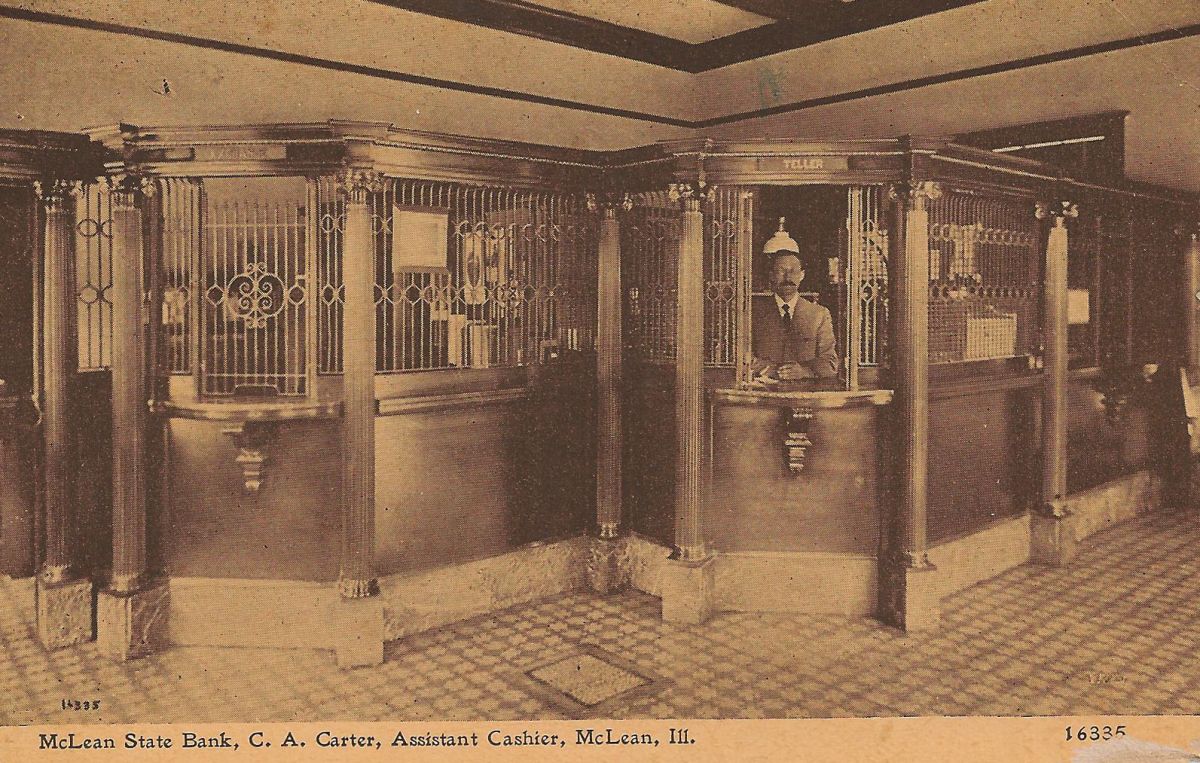 McLean State Bank interior, early 1900s. Under Frank W. Aldrich’s leadership, it was one of three banks to stay solvent in McLean County after the 1932 bank holiday. Directors included Dean N. Funk, I. G. Funk, Joseph W. Stubblefield, and B. A. Canfield.
McLean State Bank interior, early 1900s. Under Frank W. Aldrich’s leadership, it was one of three banks to stay solvent in McLean County after the 1932 bank holiday. Directors included Dean N. Funk, I. G. Funk, Joseph W. Stubblefield, and B. A. Canfield.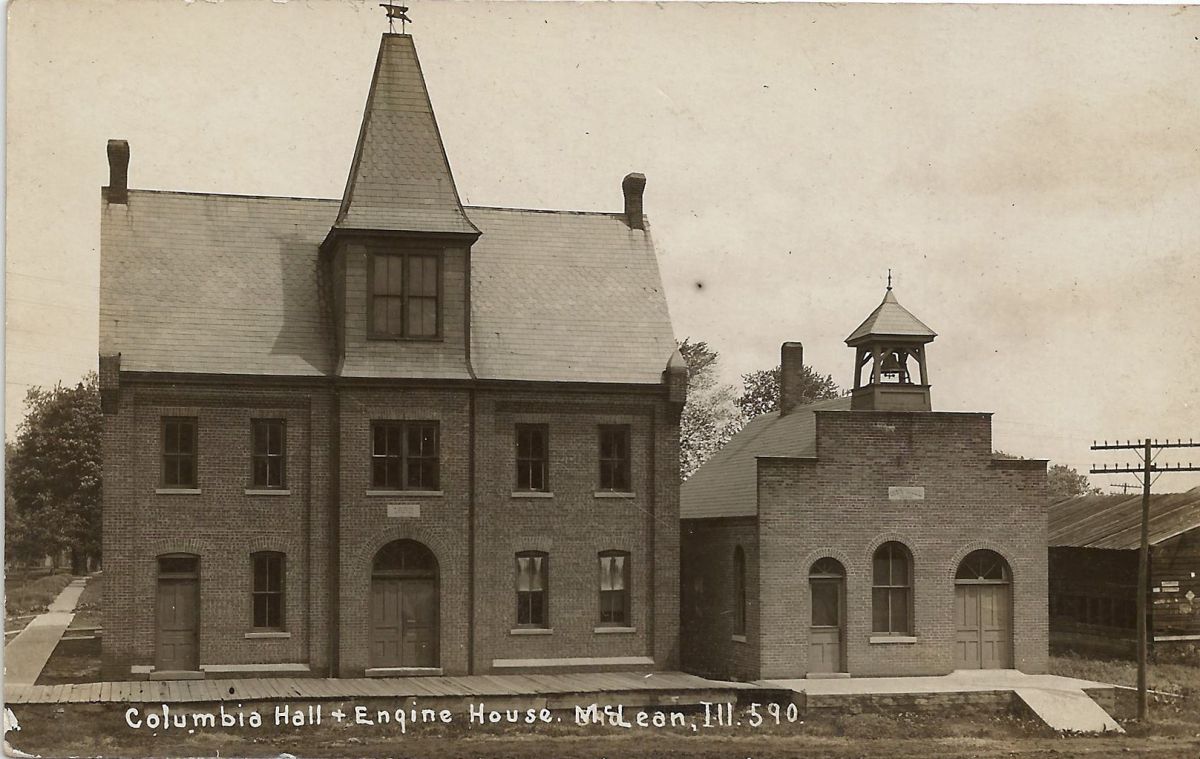 Columbia Hall and Engine House, circa 1907. These were built in 1892-93; Columbia Hall was destroyed by fire in 1915. The Mt. Hope Township Community Hall was built in its place in 1917. Courtesy of Jerome and Alene Robinson.
Columbia Hall and Engine House, circa 1907. These were built in 1892-93; Columbia Hall was destroyed by fire in 1915. The Mt. Hope Township Community Hall was built in its place in 1917. Courtesy of Jerome and Alene Robinson.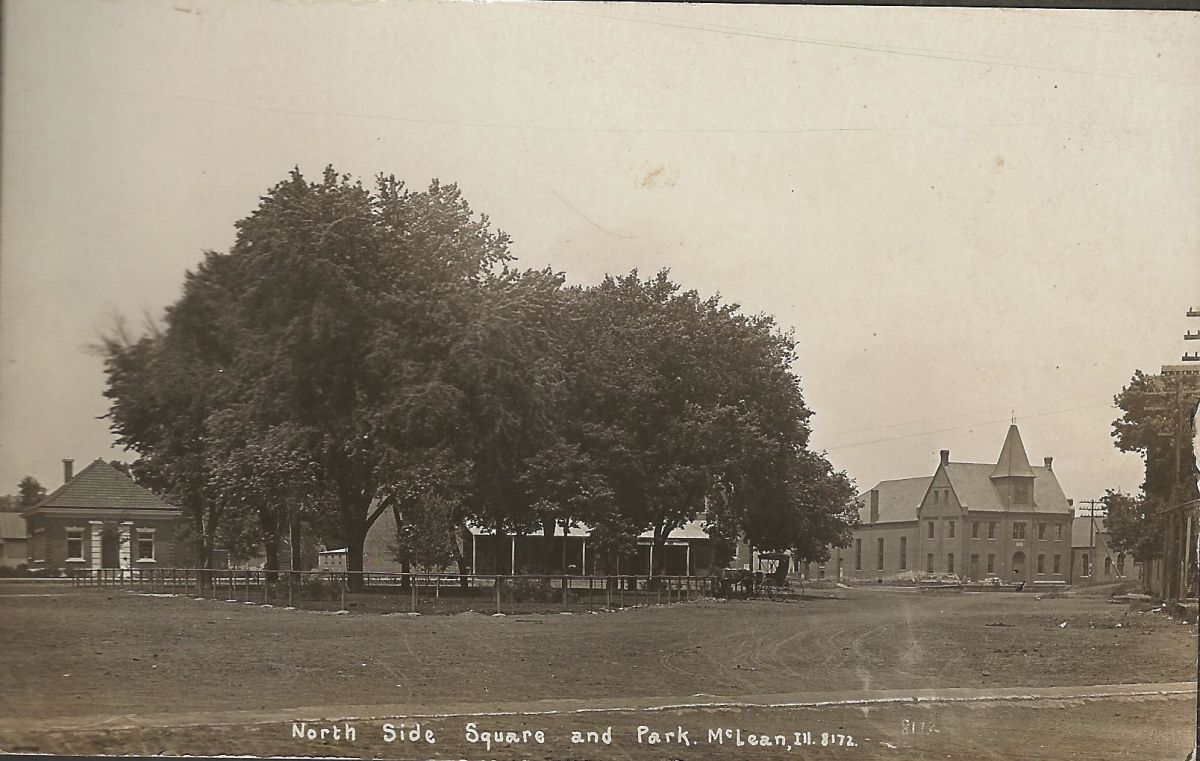 Village Square and Park, circa 1908. The bank building, erected in 1907, is visible on the left, and Columbia Hall is visible on the right.
Village Square and Park, circa 1908. The bank building, erected in 1907, is visible on the left, and Columbia Hall is visible on the right.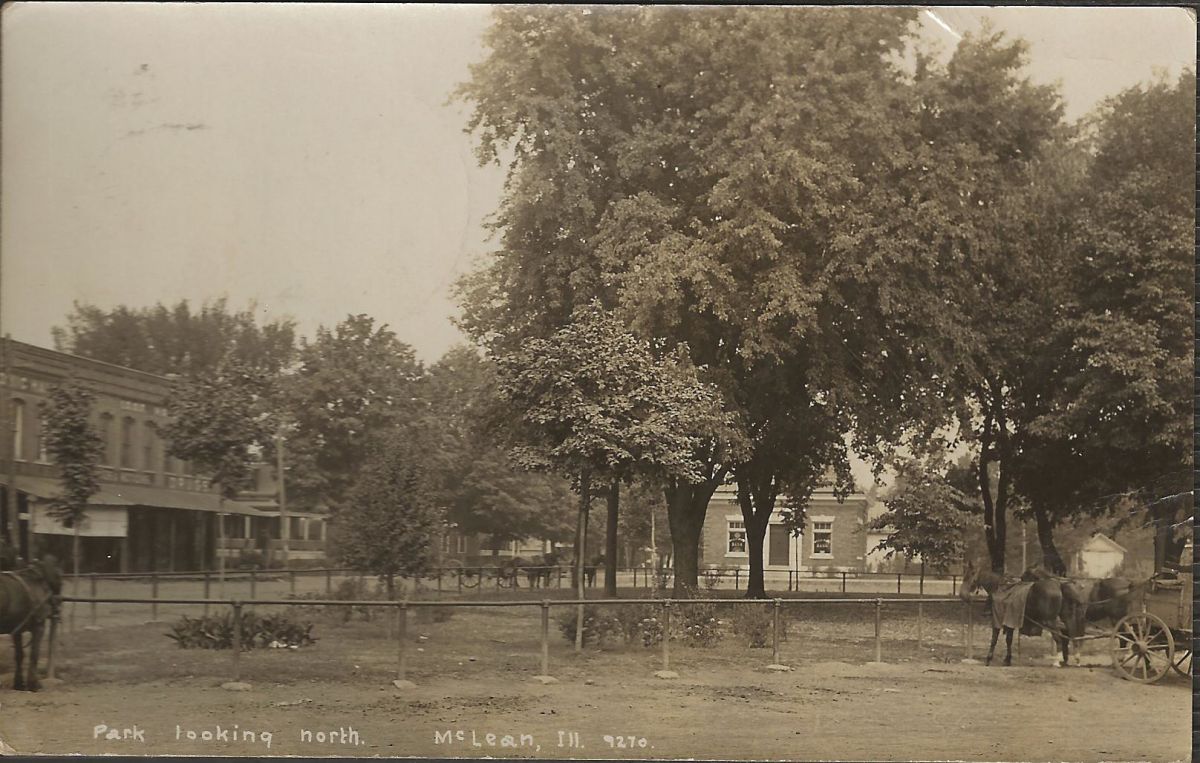 Village Square and Park, circa 1908. Still standing today are the building on the left, erected early 1880s; the house partially visible behind and to the right of it, built in 1869 by C. C. Aldrich; and the bank building (center/right), erected in 1907.
Village Square and Park, circa 1908. Still standing today are the building on the left, erected early 1880s; the house partially visible behind and to the right of it, built in 1869 by C. C. Aldrich; and the bank building (center/right), erected in 1907.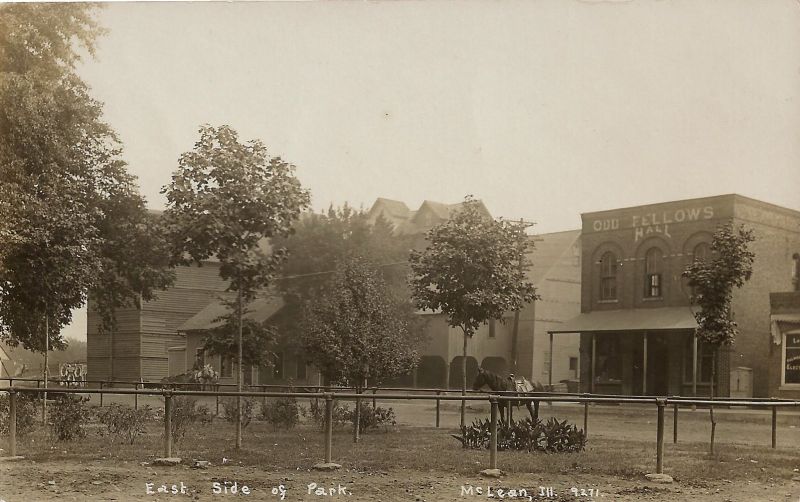 Village Square and Park, circa 1908. The large buildings in the center of the photo are the C. C. Aldrich Elevator and Mt. Hope Mills, built in 1868 and burned down in 1915. The brick building marked “Odd Fellows Hall” (right) still stands there today.
Village Square and Park, circa 1908. The large buildings in the center of the photo are the C. C. Aldrich Elevator and Mt. Hope Mills, built in 1868 and burned down in 1915. The brick building marked “Odd Fellows Hall” (right) still stands there today.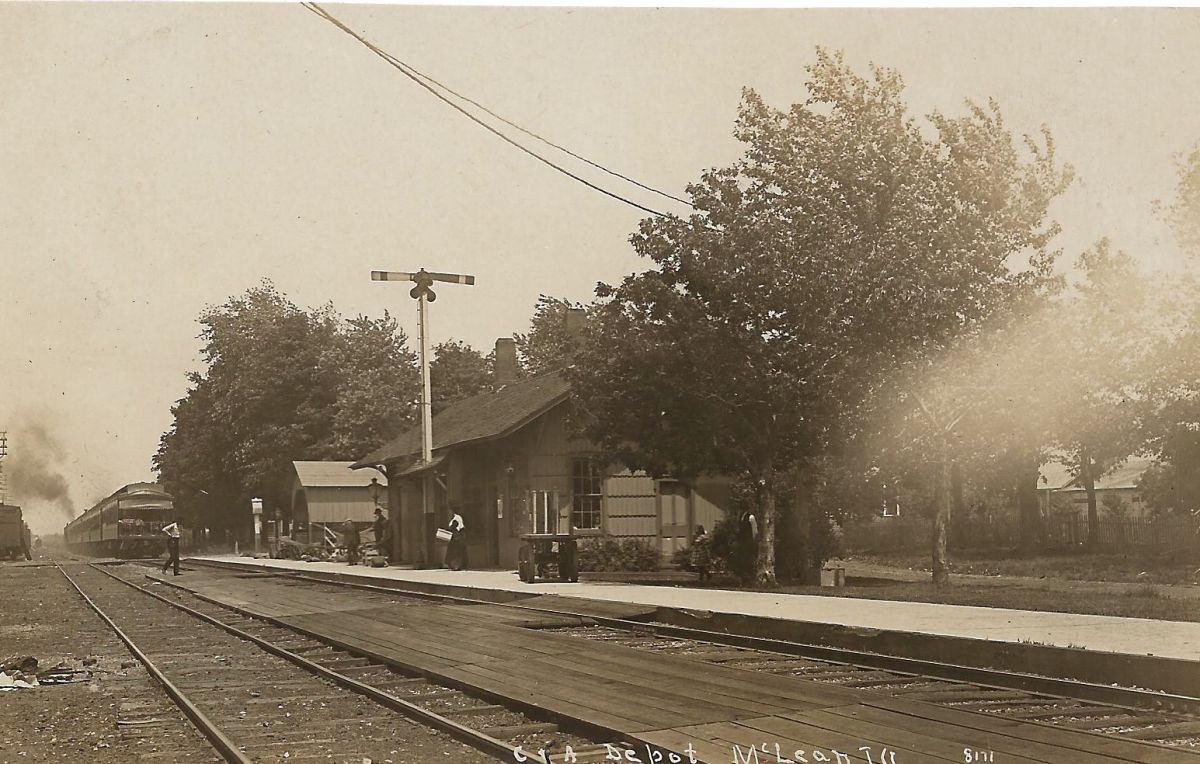 McLean Depot, circa 1912. Erected in 1855, it is said to have been the first building in McLean. The double tracks shown here were completed from Chicago to St. Louis around 1909. The depot was moved in 1971 to its present location across from the Dixie.
McLean Depot, circa 1912. Erected in 1855, it is said to have been the first building in McLean. The double tracks shown here were completed from Chicago to St. Louis around 1909. The depot was moved in 1971 to its present location across from the Dixie. C. C. Aldrich & Son grain elevator, circa 1916. This was built in the same location as the C. C. Aldrich Elevator and Mt. Hope Mills (SE corner of village square) after they were destroyed by fire in 1915. The mill facilities were not rebuilt.
C. C. Aldrich & Son grain elevator, circa 1916. This was built in the same location as the C. C. Aldrich Elevator and Mt. Hope Mills (SE corner of village square) after they were destroyed by fire in 1915. The mill facilities were not rebuilt.  Mt. Hope Township Community Hall and Library, 1917, just after its completion. The hall was used as the McLean High School gym and auditorium until 1950 and is still used for events today. Courtesy of the McLean County Museum of History.
Mt. Hope Township Community Hall and Library, 1917, just after its completion. The hall was used as the McLean High School gym and auditorium until 1950 and is still used for events today. Courtesy of the McLean County Museum of History. Bloomington Pantagraph ad from 1922 for an event at the Community Hall, which the newspaper noted to be “intended for use by any society, club or group of people for any purpose of community benefit.” Courtesy of the McLean County Museum of History.
Bloomington Pantagraph ad from 1922 for an event at the Community Hall, which the newspaper noted to be “intended for use by any society, club or group of people for any purpose of community benefit.” Courtesy of the McLean County Museum of History.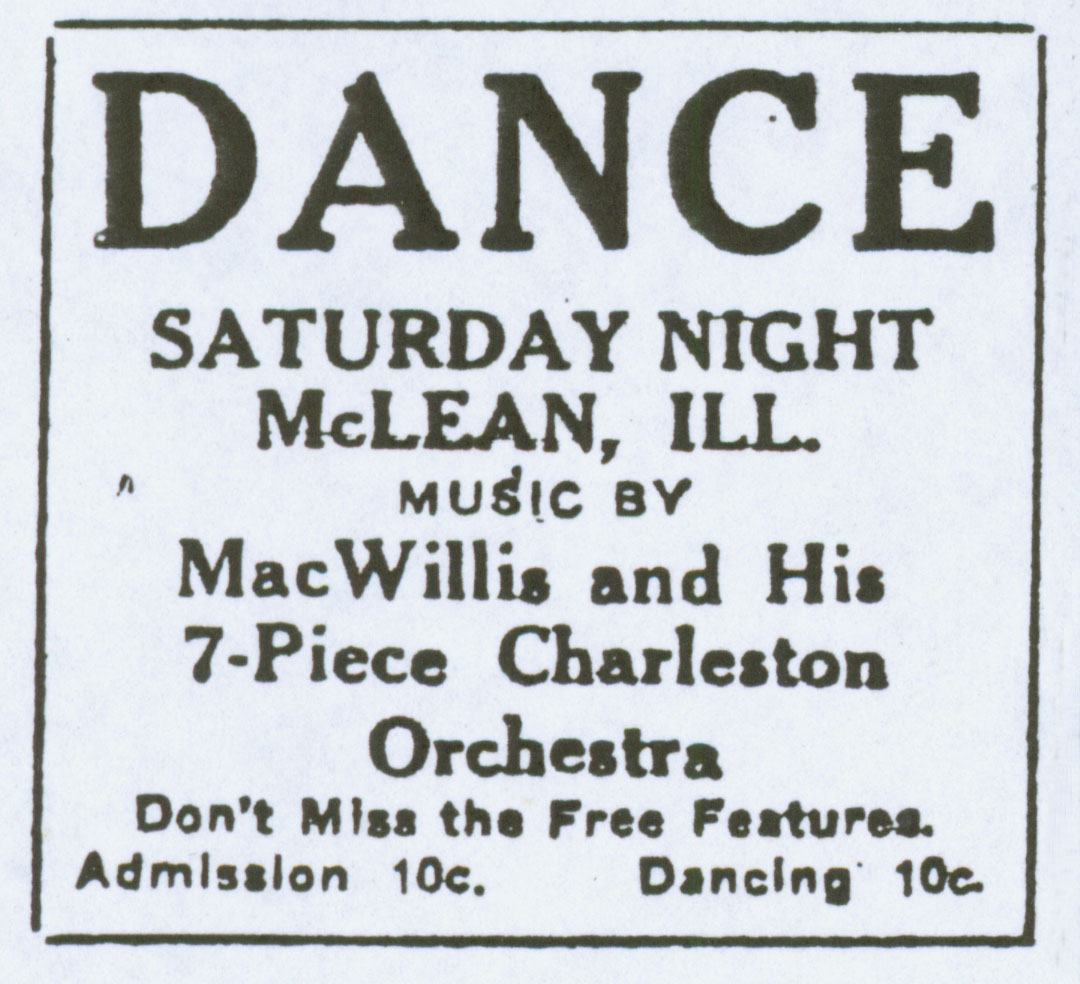 Bloomington Pantagraph ad, 1926. Dances, movie showings, and other events were held in the gymnasium/auditorium, which still boasts its stage and balcony, as well as the downstairs kitchen/dining hall. Courtesy of the McLean County Museum of History.
Bloomington Pantagraph ad, 1926. Dances, movie showings, and other events were held in the gymnasium/auditorium, which still boasts its stage and balcony, as well as the downstairs kitchen/dining hall. Courtesy of the McLean County Museum of History.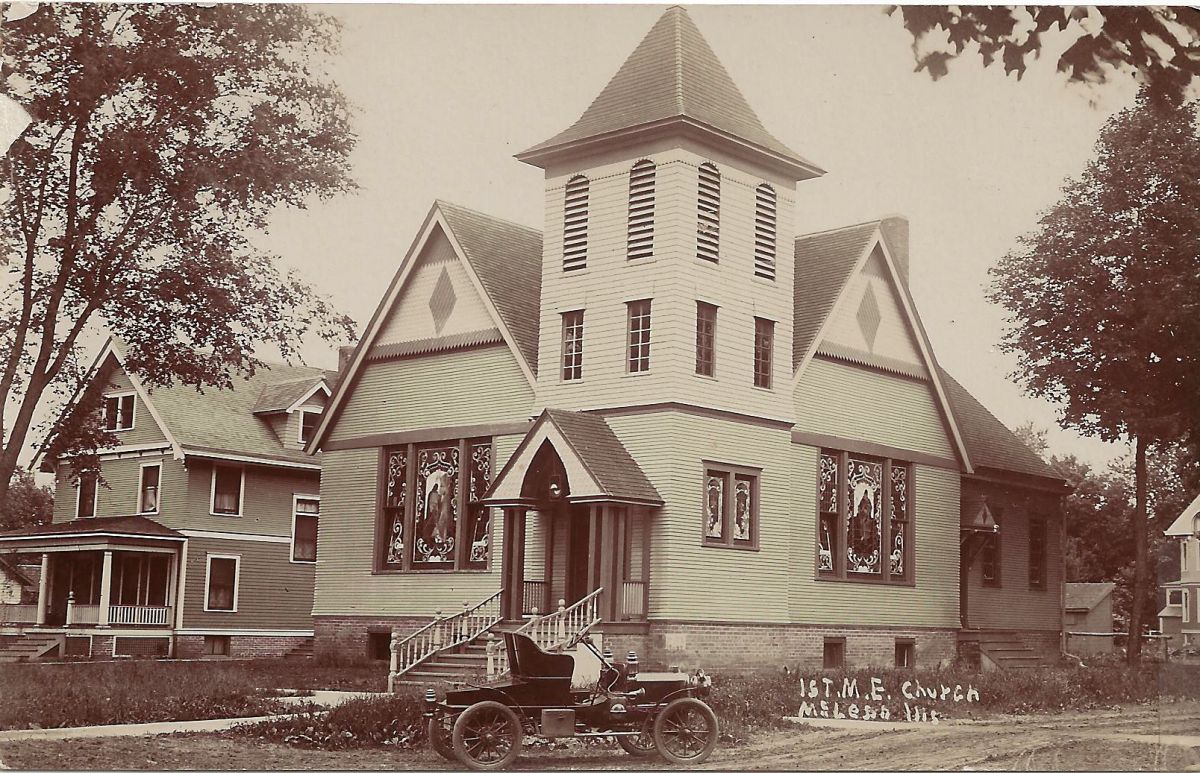 McLean Methodist Church, early 1900s. Organized in 1856–57, McLean Methodists built their first church in 1866. In 1900 that was torn down, and this church, which still stands at Franklin & Blatchford, was built across the street from the old location.
McLean Methodist Church, early 1900s. Organized in 1856–57, McLean Methodists built their first church in 1866. In 1900 that was torn down, and this church, which still stands at Franklin & Blatchford, was built across the street from the old location.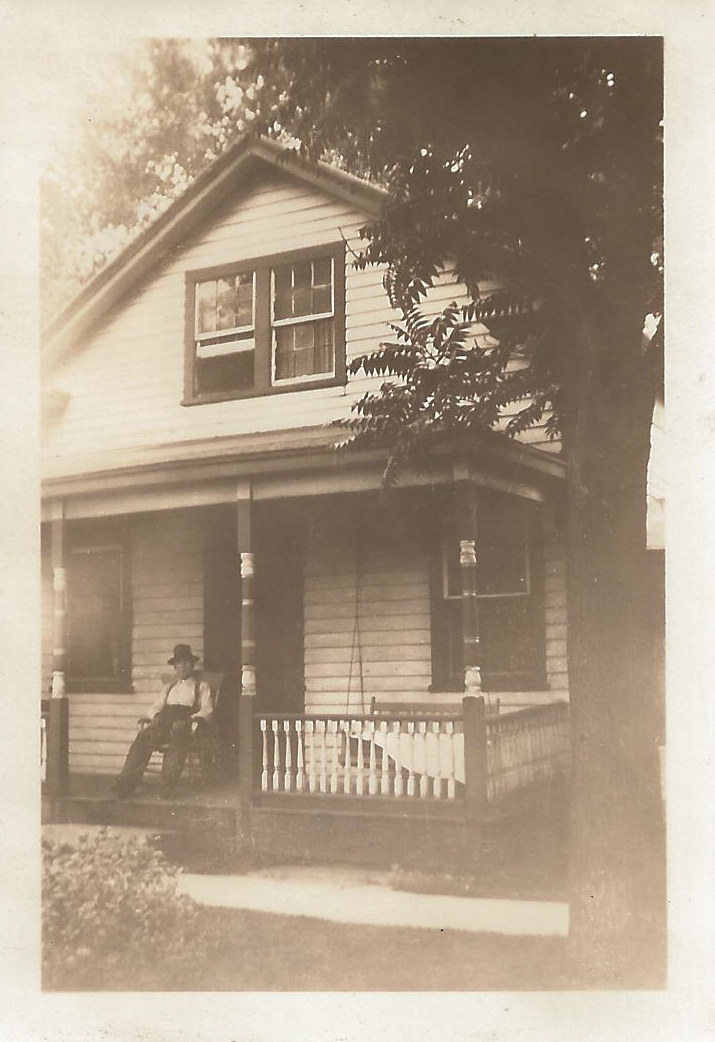 First house built in McLean, photo taken in 1937. Location, original owners, and date it was built are unknown. Shown may be Rev. C. R. Barr, who served the Church of God 1935–1951 and lived there as of 1955, or P. O. Cowan, who resided there previously.
First house built in McLean, photo taken in 1937. Location, original owners, and date it was built are unknown. Shown may be Rev. C. R. Barr, who served the Church of God 1935–1951 and lived there as of 1955, or P. O. Cowan, who resided there previously.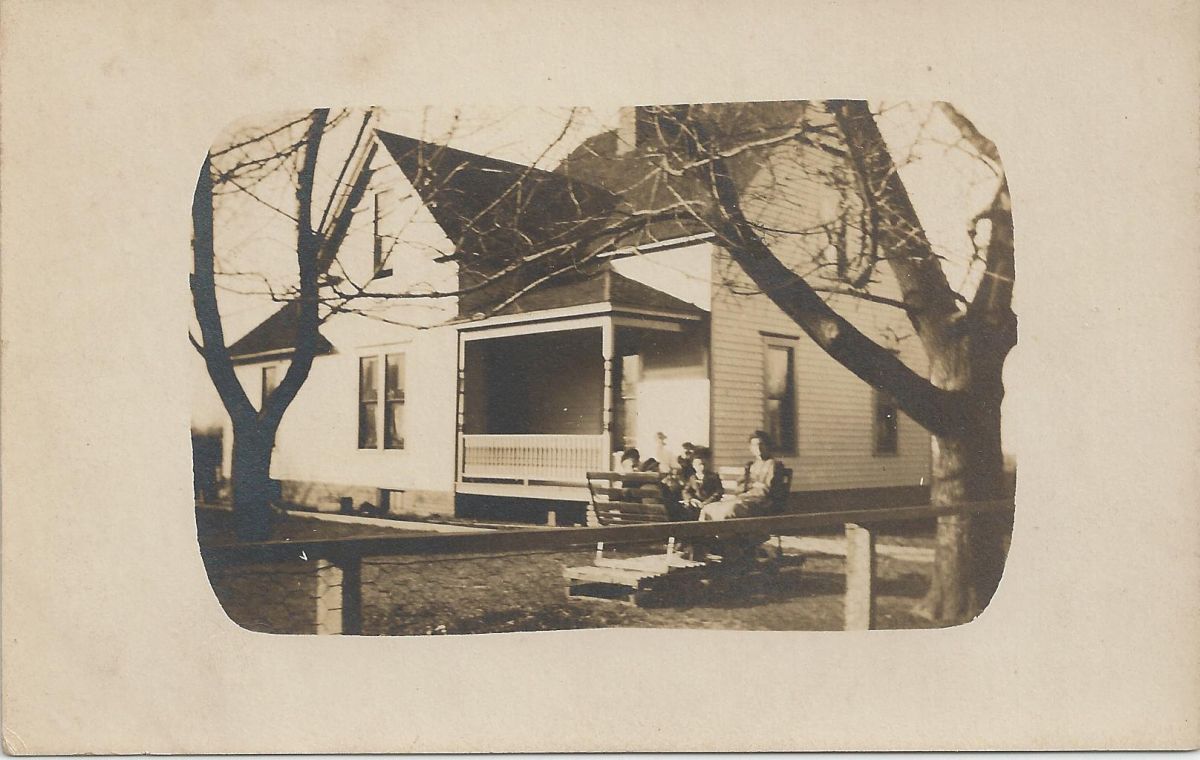 House in McLean, circa 1930s. Location and individuals pictured are unknown.
House in McLean, circa 1930s. Location and individuals pictured are unknown. House in McLean, circa 1930s. Location and individuals pictured are unknown.
House in McLean, circa 1930s. Location and individuals pictured are unknown.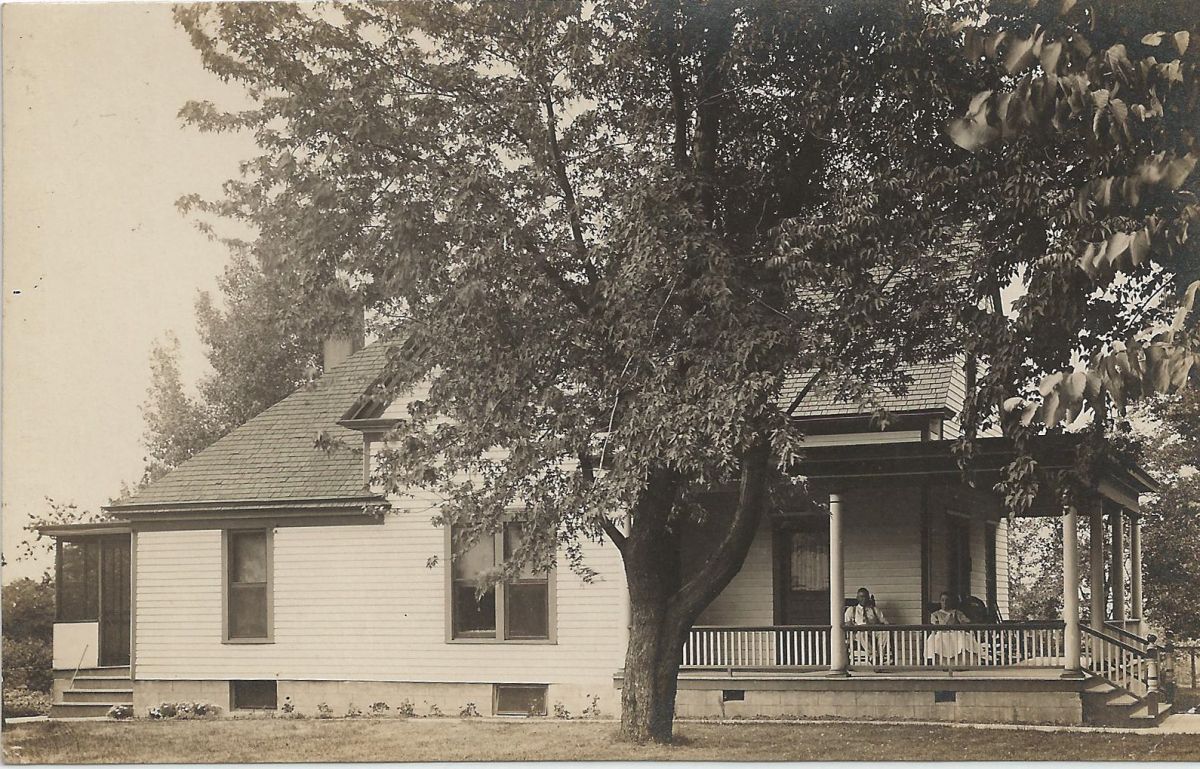 House in McLean, circa 1930s. Location and individuals pictured are unknown.
House in McLean, circa 1930s. Location and individuals pictured are unknown.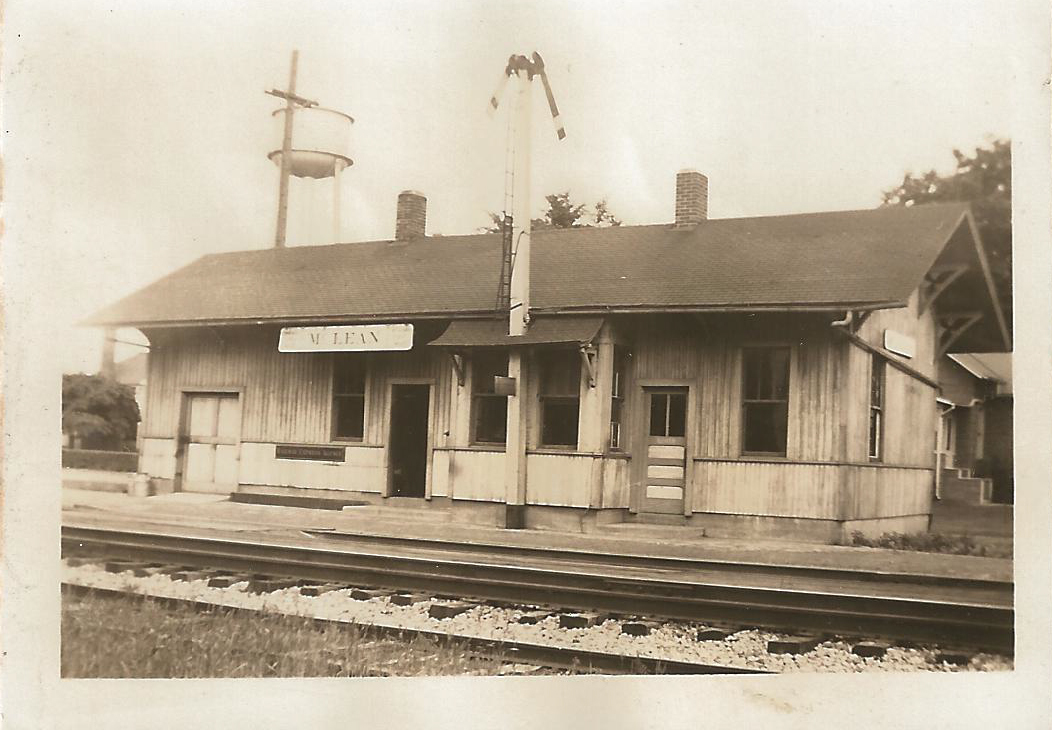 McLean Depot, 1937. William Hilligoss would have been the McLean station agent at this time; he served from 1914 until his retirement in 1970 and was well known and liked by the townspeople.
McLean Depot, 1937. William Hilligoss would have been the McLean station agent at this time; he served from 1914 until his retirement in 1970 and was well known and liked by the townspeople. Funks Grove Church, 1937. The church was built in 1864-65 by Isaac Funk, Robert Stubblefield, and their sons and still stands in its original location in Funks Grove (a few miles north of McLean) today.
Funks Grove Church, 1937. The church was built in 1864-65 by Isaac Funk, Robert Stubblefield, and their sons and still stands in its original location in Funks Grove (a few miles north of McLean) today.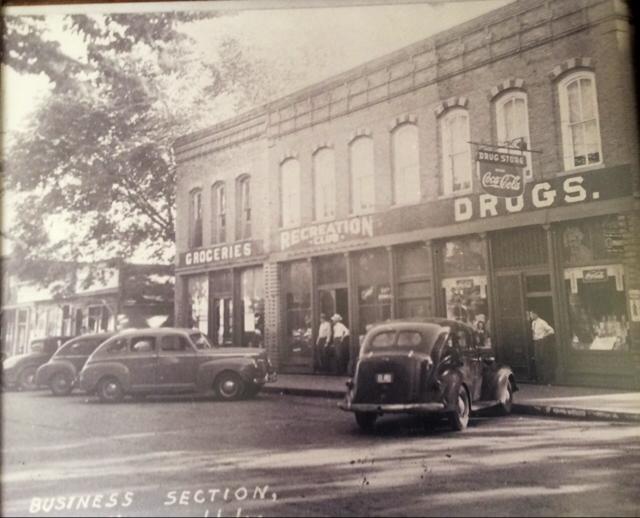 Village Square, corner of Morgan and Hamilton, late 1940s. Visible (left to right) are a grocery store (Kinsey’s?), first location of the McLean Recreation Hall, and Holohan’s Drug Store. This building, erected circa 1880, still stands today.
Village Square, corner of Morgan and Hamilton, late 1940s. Visible (left to right) are a grocery store (Kinsey’s?), first location of the McLean Recreation Hall, and Holohan’s Drug Store. This building, erected circa 1880, still stands today.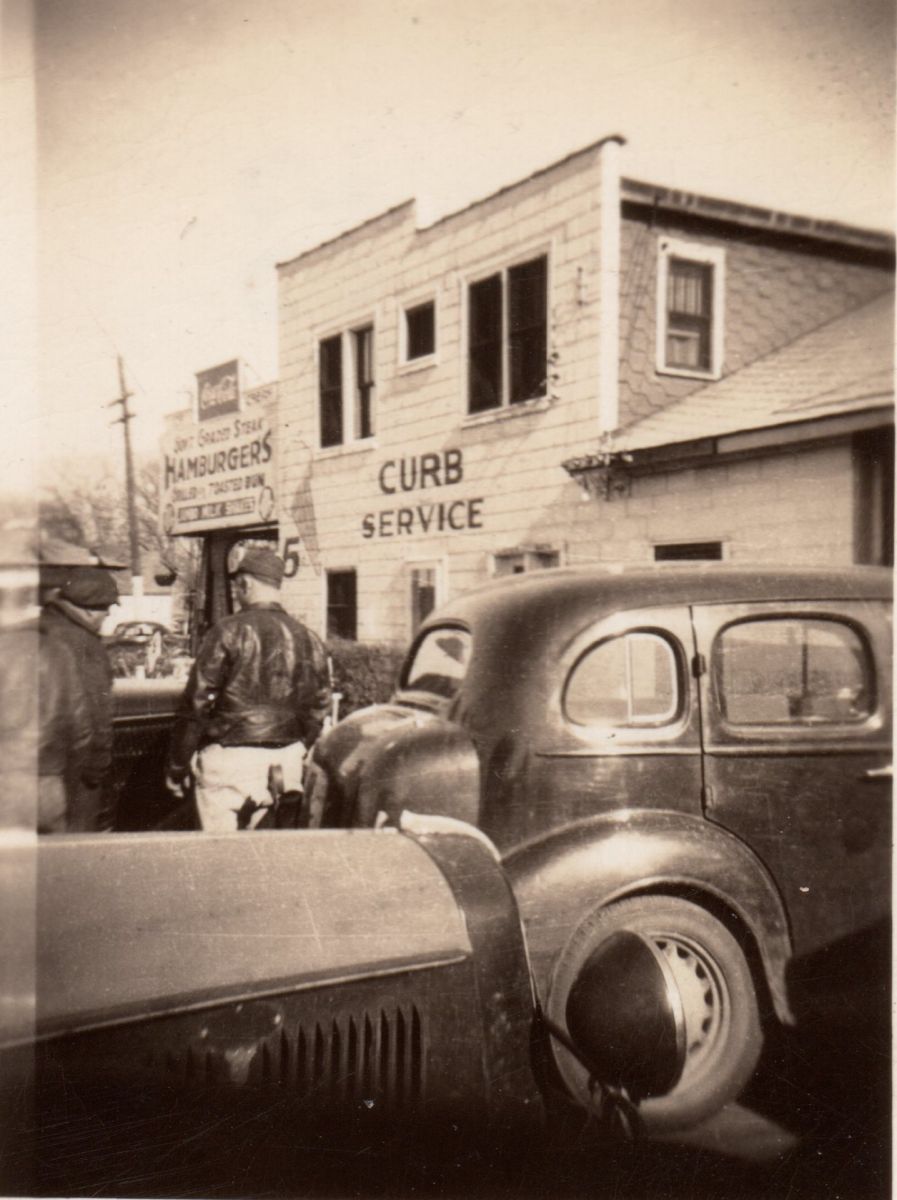 The Dixie Truckers Home, 1948. This is the original building, which was destroyed by fire in 1965. Established in 1928 by J. P. Walters, the Dixie is the oldest truck stop in America. Courtesy of Barb Farmer.
The Dixie Truckers Home, 1948. This is the original building, which was destroyed by fire in 1965. Established in 1928 by J. P. Walters, the Dixie is the oldest truck stop in America. Courtesy of Barb Farmer.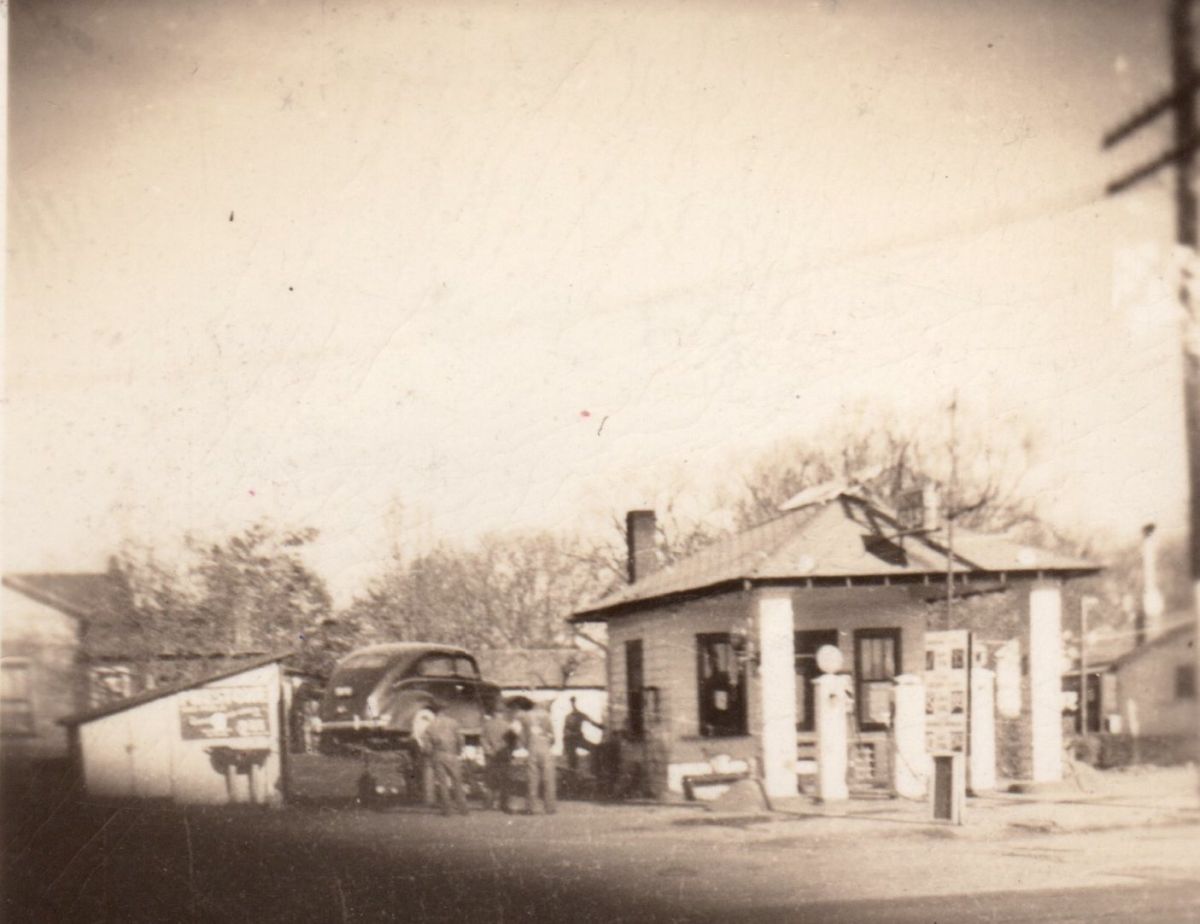 The Illico Station, 1948. This small gas and service station was located across from the Dixie on Highway 136 (where there is currently an open grassy lot). In 1955 the name was changed to the Apco Service Station. Courtesy of Barb Farmer.
The Illico Station, 1948. This small gas and service station was located across from the Dixie on Highway 136 (where there is currently an open grassy lot). In 1955 the name was changed to the Apco Service Station. Courtesy of Barb Farmer.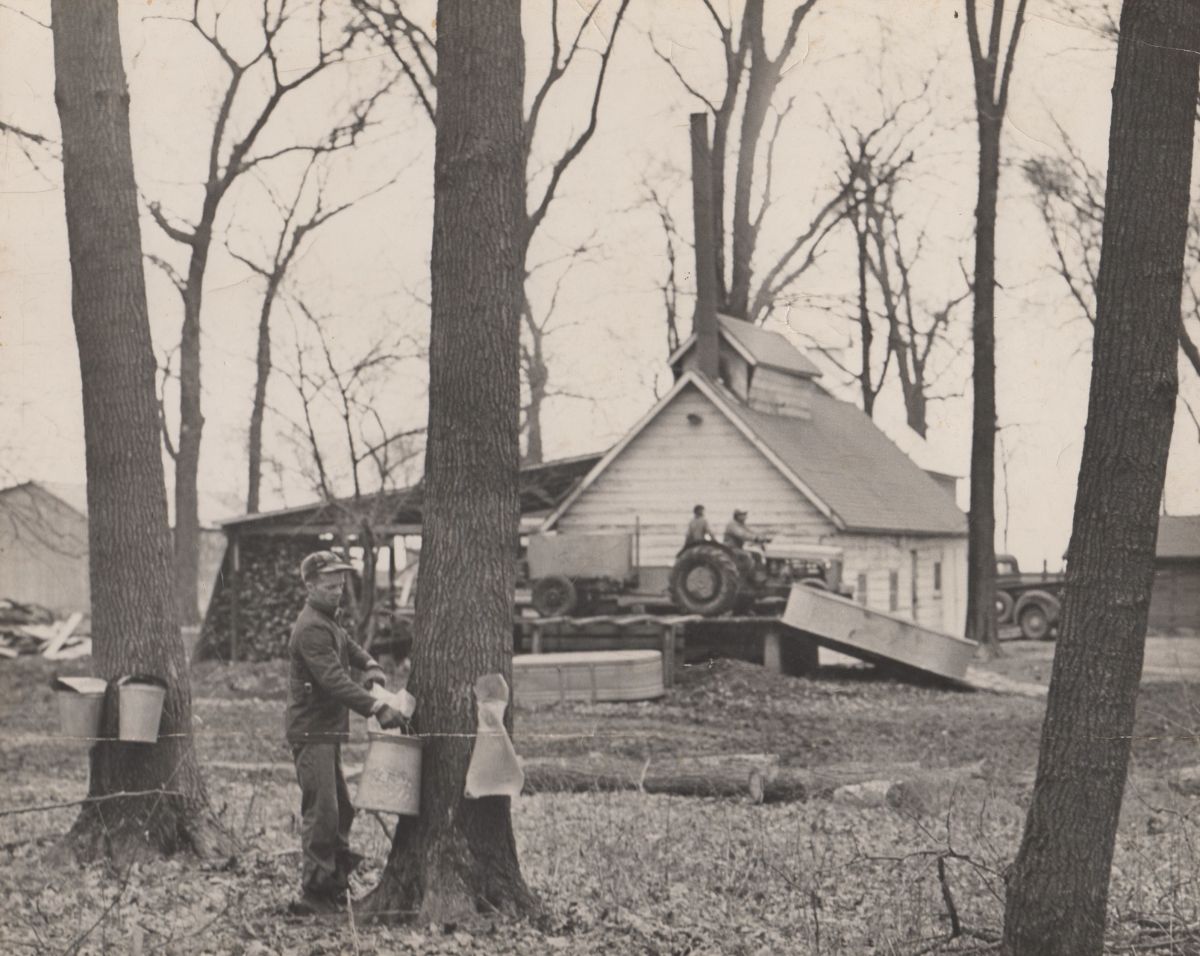 Funks Grove Pure Maple Sirup; Stephen C. Funk in the foreground, circa 1950. The business was established by Arthur Funk in 1891 and moved to this (its current) location by Hazel Funk Holmes in the 1920s. The sugarhouse pictured was built in 1930.
Funks Grove Pure Maple Sirup; Stephen C. Funk in the foreground, circa 1950. The business was established by Arthur Funk in 1891 and moved to this (its current) location by Hazel Funk Holmes in the 1920s. The sugarhouse pictured was built in 1930. 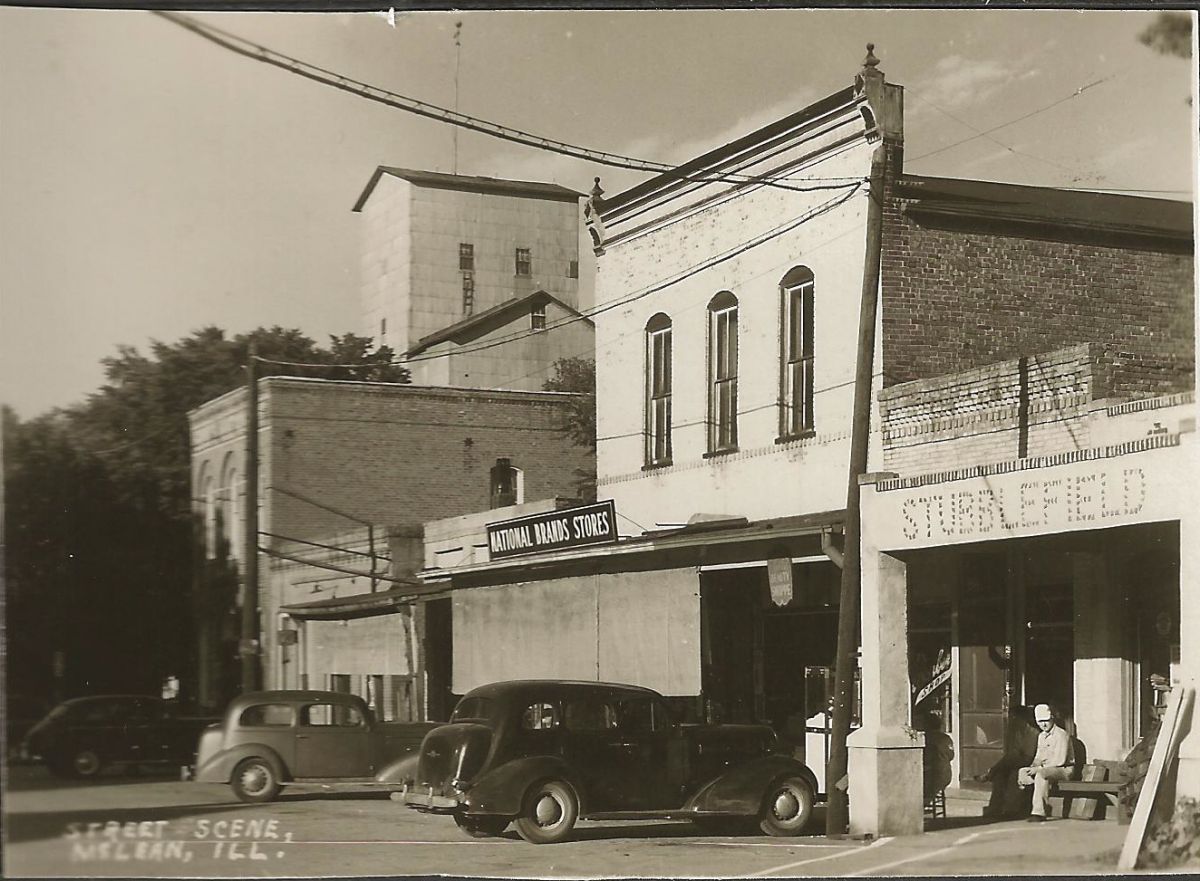 Village Square; Park St., circa 1950. Exact date of photo unknown, but appears to be previous to the establishment of Steward’s Cafe (1952) and McLean Bargain House (1954). Entrance to the Ben H. Stubblefield Elevator and Mill is visible on the right.
Village Square; Park St., circa 1950. Exact date of photo unknown, but appears to be previous to the establishment of Steward’s Cafe (1952) and McLean Bargain House (1954). Entrance to the Ben H. Stubblefield Elevator and Mill is visible on the right.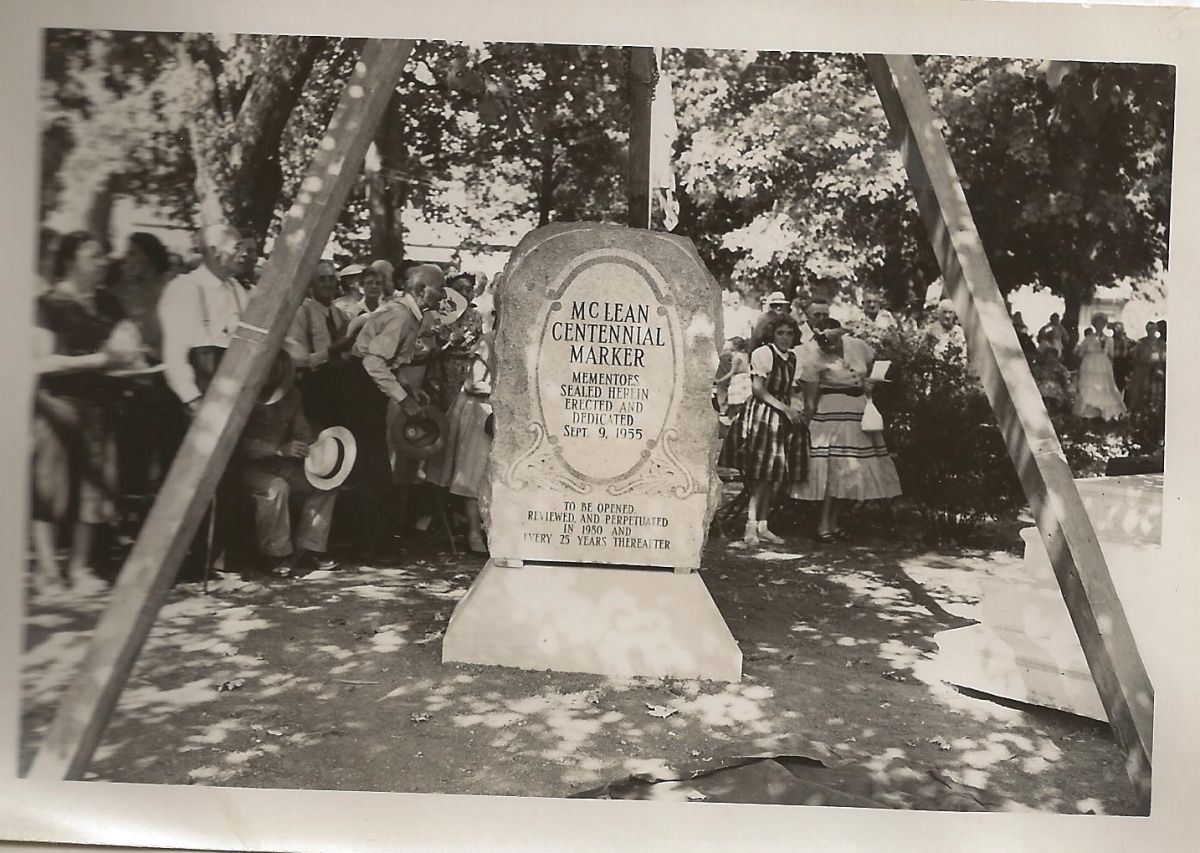 McLean Centennial Marker being placed in Village Square Park, September 9, 1955. A time capsule was placed, to be reviewed and updated every 25 years.
McLean Centennial Marker being placed in Village Square Park, September 9, 1955. A time capsule was placed, to be reviewed and updated every 25 years.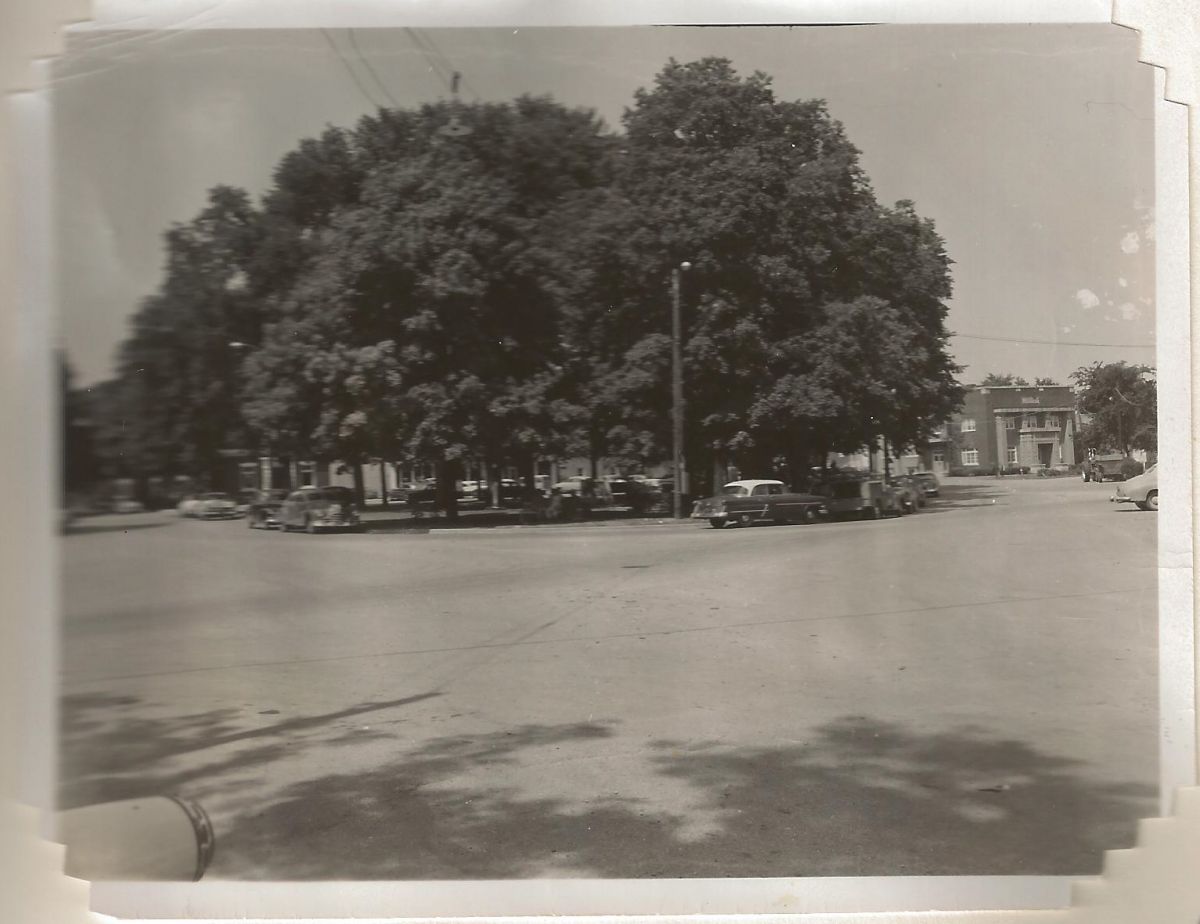 Village Square Park, circa 1955, looking northeast. Partially visible is the bank building (left), which was at this time the post office, with Shorty’s Barber Shop and the VanNess Beauty Shop in the basement. Next door was Taylor’s IGA & hardware store.
Village Square Park, circa 1955, looking northeast. Partially visible is the bank building (left), which was at this time the post office, with Shorty’s Barber Shop and the VanNess Beauty Shop in the basement. Next door was Taylor’s IGA & hardware store.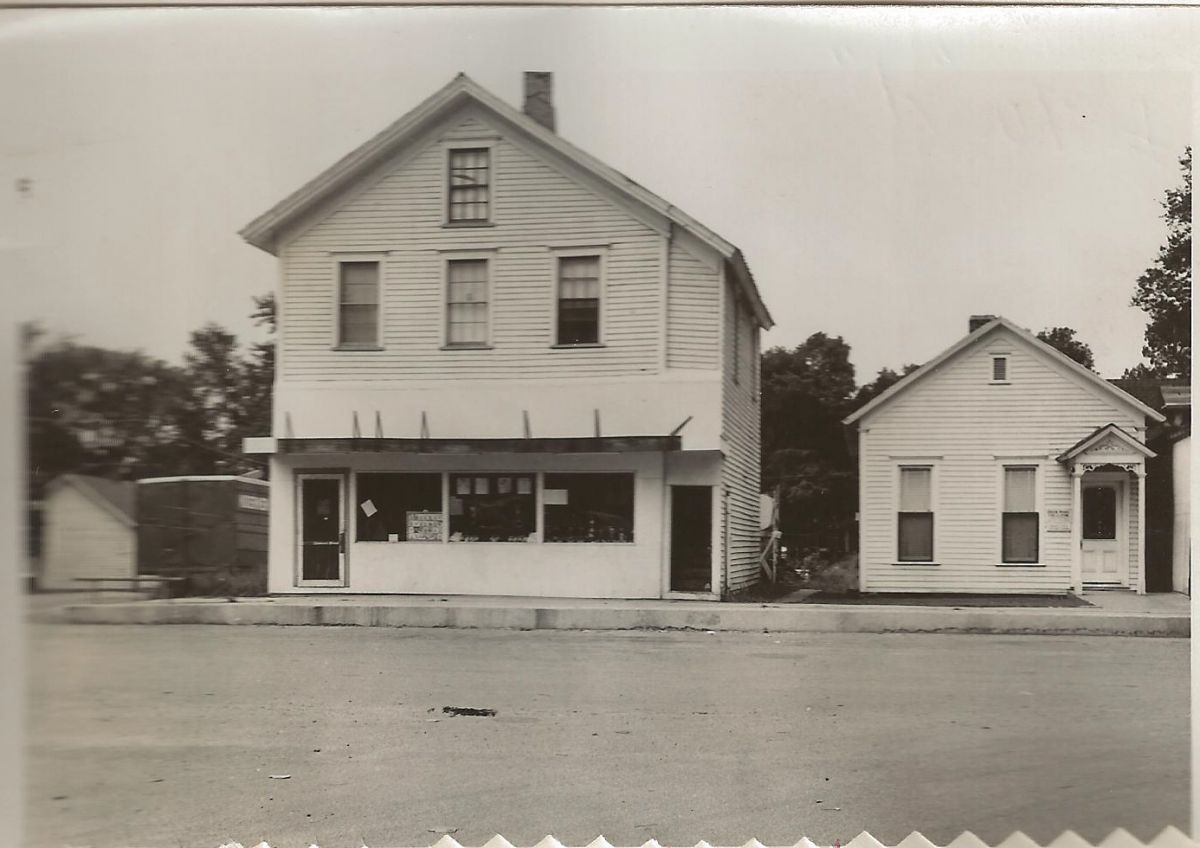 Village Square, Hamilton St., 1955. Building on left was the location of Taylor’s grocery store 1939–1953 (current location of the McLean Village Office); office of physician and surgeon Dr. Thomas Smith on right (current location of McLean Post Office).
Village Square, Hamilton St., 1955. Building on left was the location of Taylor’s grocery store 1939–1953 (current location of the McLean Village Office); office of physician and surgeon Dr. Thomas Smith on right (current location of McLean Post Office).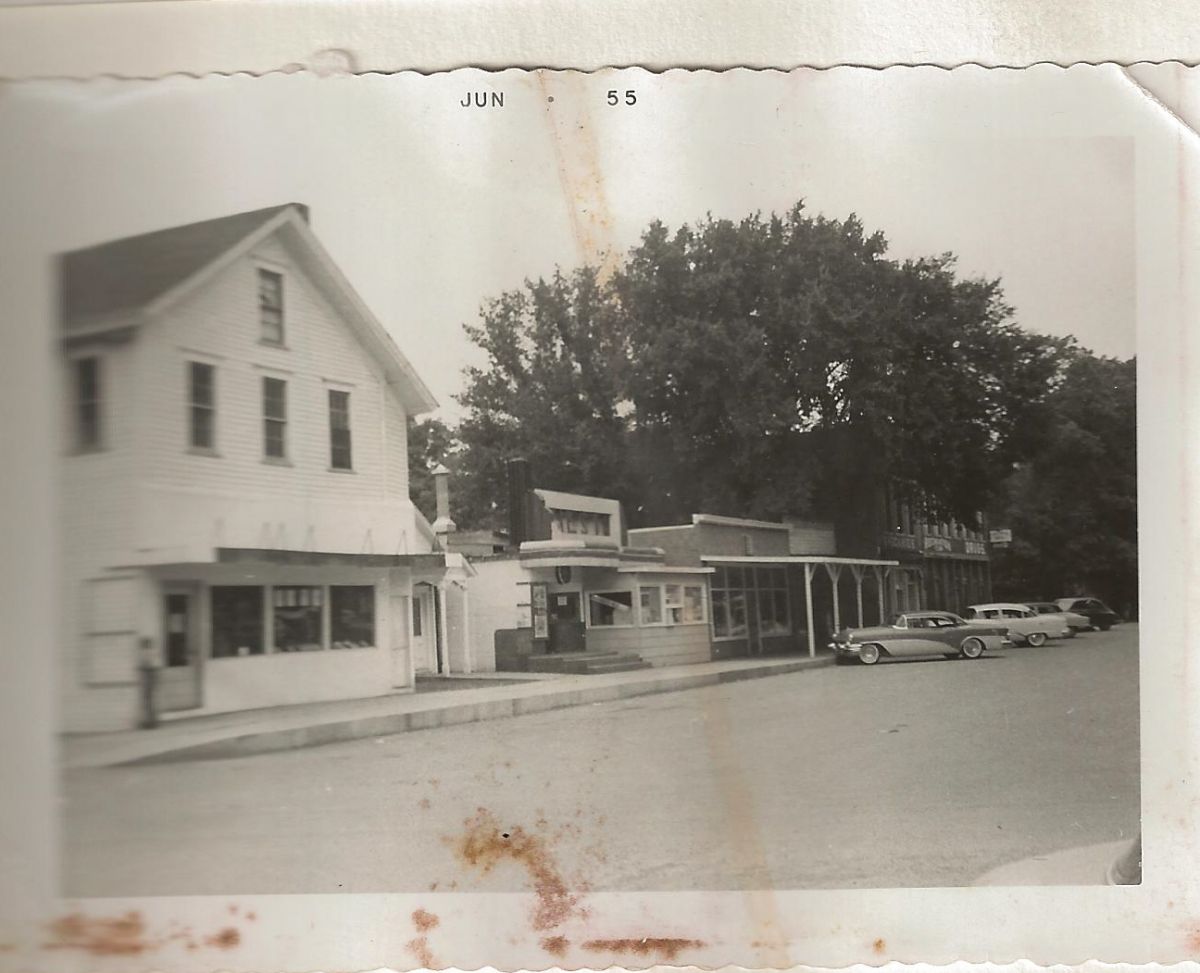 Village Square, Hamilton St., 1955. Building with rounded overhang is the Fiesta Theater, owned and operated by Emerson (Virg) Virgil and his wife, Dorothy (Dottie). Dottie’s mom Mrs. Ethel Ross served soft ice cream at the concession counter.
Village Square, Hamilton St., 1955. Building with rounded overhang is the Fiesta Theater, owned and operated by Emerson (Virg) Virgil and his wife, Dorothy (Dottie). Dottie’s mom Mrs. Ethel Ross served soft ice cream at the concession counter. Village Square, Hamilton St., 1955. Moving north from the Fiesta Theater, most likely at this time is Howard McLane’s electric shop, O. W. Earl Hardware; in brick buildings: McLean Recreation Hall, Wayne Crutchley Heating & Plumbing, and Holohan’s Drugs.
Village Square, Hamilton St., 1955. Moving north from the Fiesta Theater, most likely at this time is Howard McLane’s electric shop, O. W. Earl Hardware; in brick buildings: McLean Recreation Hall, Wayne Crutchley Heating & Plumbing, and Holohan’s Drugs. Village Square; intersection of Hamilton, Franklin, and Park Streets; circa 1955. Visible are signs for what was likely Steward’s Cafe. Mr. and Mrs. Roy Steward, Sr., came to McLean in 1952 and purchased the former Lynn Cafe from Mrs. Margaret Garner.
Village Square; intersection of Hamilton, Franklin, and Park Streets; circa 1955. Visible are signs for what was likely Steward’s Cafe. Mr. and Mrs. Roy Steward, Sr., came to McLean in 1952 and purchased the former Lynn Cafe from Mrs. Margaret Garner.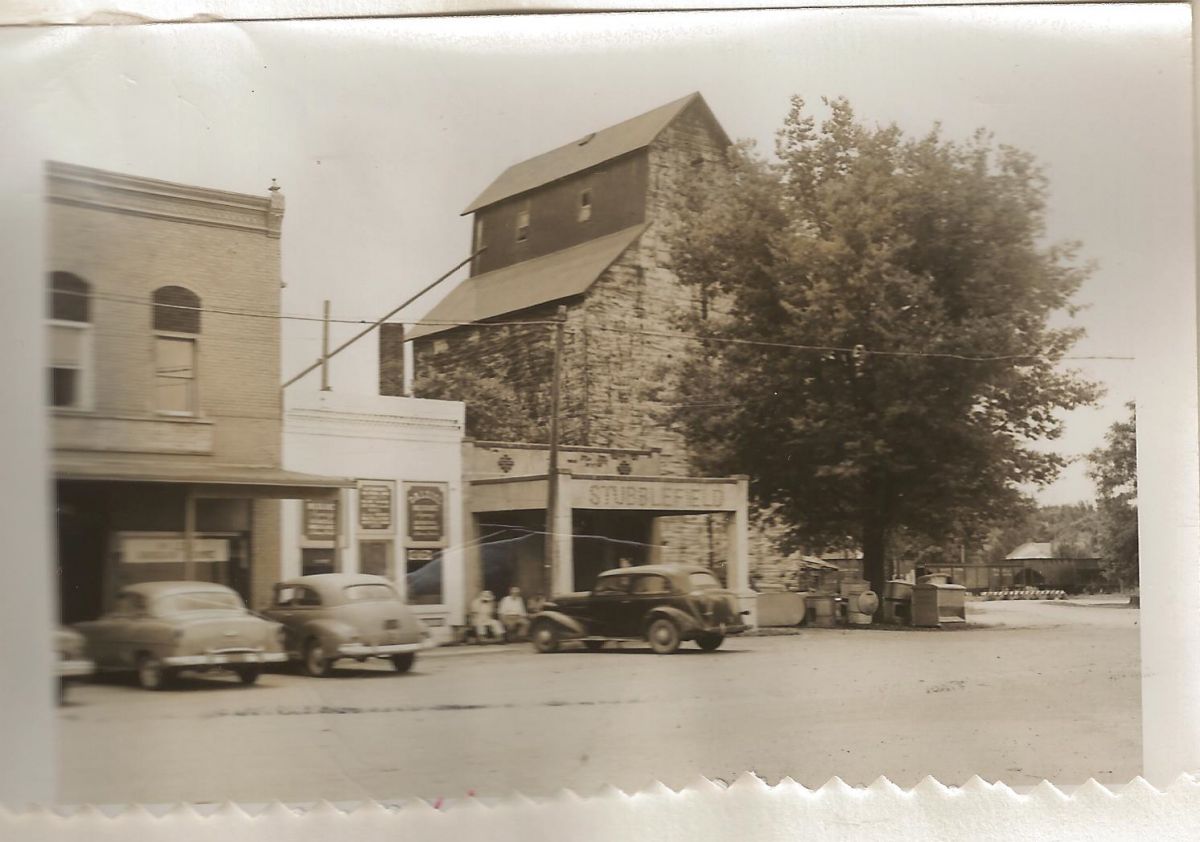 Village Square, Park St., looking southwest, circa 1955. Visible, left to right, are the McLean Bargain House, Dalziel Insurance Agency (white building), and the Ben H. Stubblefield Elevator and Mill.
Village Square, Park St., looking southwest, circa 1955. Visible, left to right, are the McLean Bargain House, Dalziel Insurance Agency (white building), and the Ben H. Stubblefield Elevator and Mill.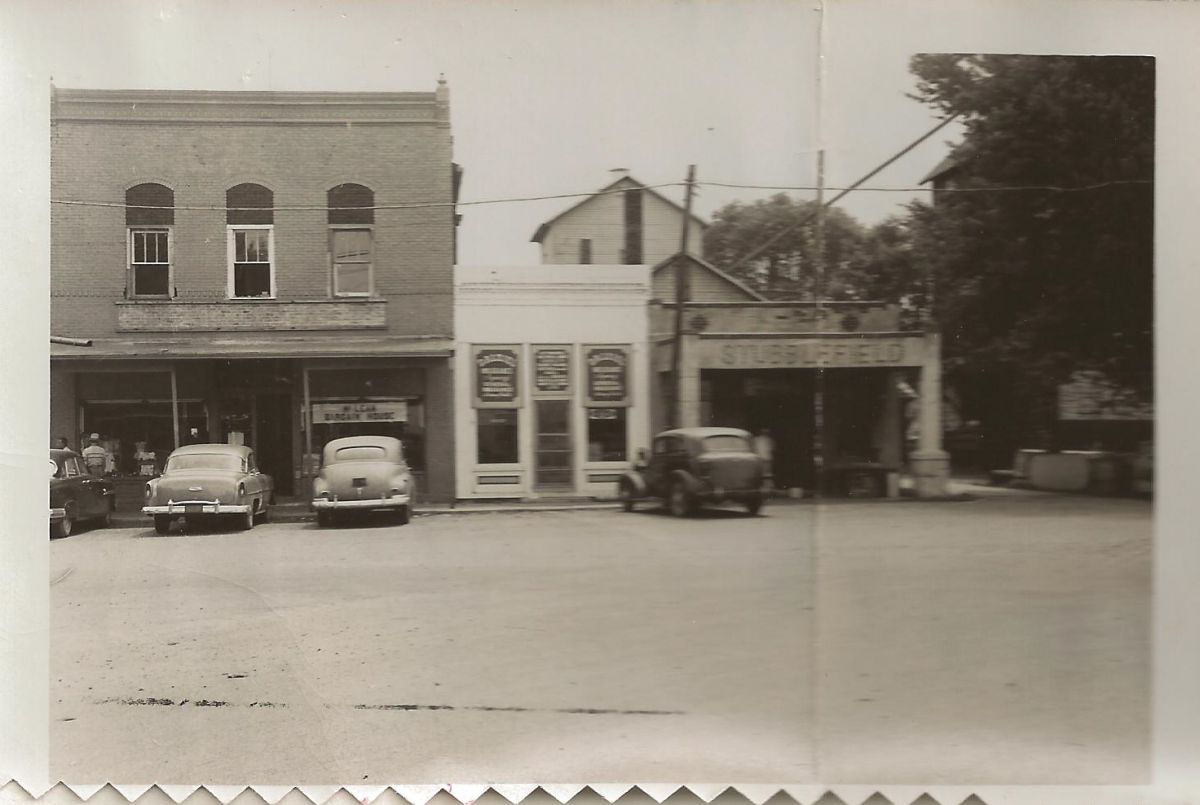 Village Square, Park St., looking south, circa 1955. The brick building with the McLean Bargain House (left) was previously C. W. Hamilton’s grocery store and today houses the McLean Hardware Store. The other buildings pictured have since been torn down.
Village Square, Park St., looking south, circa 1955. The brick building with the McLean Bargain House (left) was previously C. W. Hamilton’s grocery store and today houses the McLean Hardware Store. The other buildings pictured have since been torn down. Ben H. Stubblefield Elevator and Mill, 1955. The elevator was built in 1915 by Darnall & Spence, sold to W. W. Hill in 1917, and purchased by Farmers Co-operative Grain & Supply Co. in 1918. Stubblefield purchased it in 1925 and built the mill in 1928.
Ben H. Stubblefield Elevator and Mill, 1955. The elevator was built in 1915 by Darnall & Spence, sold to W. W. Hill in 1917, and purchased by Farmers Co-operative Grain & Supply Co. in 1918. Stubblefield purchased it in 1925 and built the mill in 1928. Village Square, Park St., 1955. James T. Dalziel set up his barbershop in the white building in 1916 and in 1928 set up an insurance office in the back. After he retired in 1950, his wife and then his son, Jim Jr., took over the insurance agency.
Village Square, Park St., 1955. James T. Dalziel set up his barbershop in the white building in 1916 and in 1928 set up an insurance office in the back. After he retired in 1950, his wife and then his son, Jim Jr., took over the insurance agency.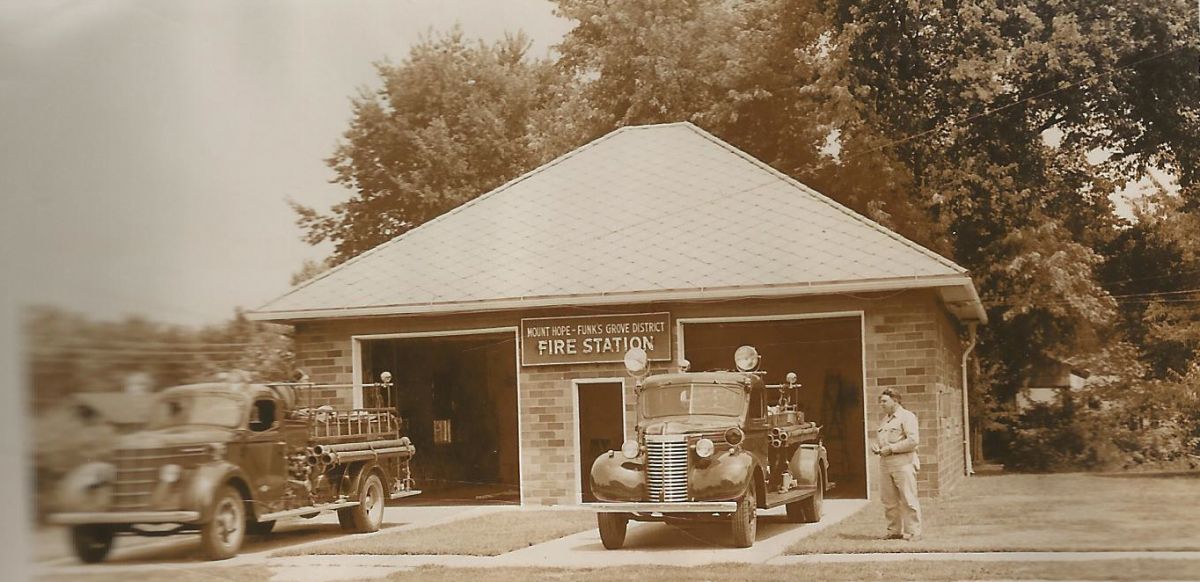 Mt. Hope–Funks Grove Fire Station, 1955. The fire district was organized in 1937; the station was built in 1938. Fire commissioners in 1955 were J. D. Roberts, LaFayette Funk, and R. A. Bowers. The building still stands near the RR crossing on Center St.
Mt. Hope–Funks Grove Fire Station, 1955. The fire district was organized in 1937; the station was built in 1938. Fire commissioners in 1955 were J. D. Roberts, LaFayette Funk, and R. A. Bowers. The building still stands near the RR crossing on Center St.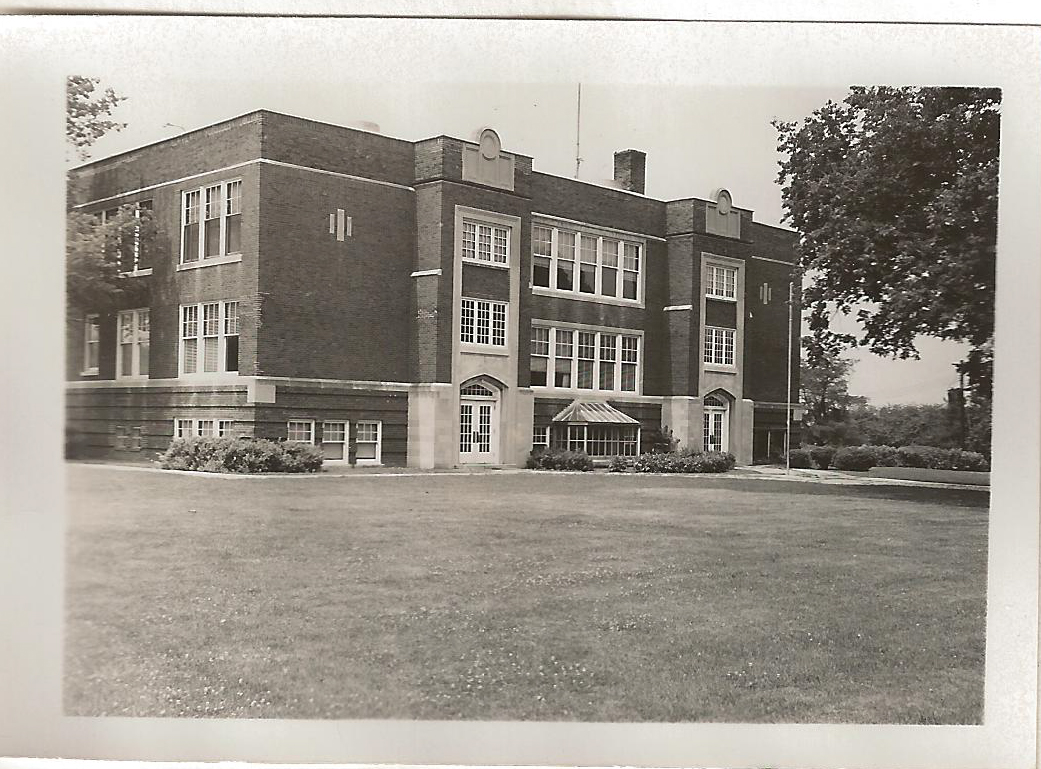 McLean High School, 1955. Built in 1920, the school also later served Waynesville (1955) and Armington (1968) students. It closed in 1972, and in 1980 all was demolished except the gym, which was used by the new grade school (now the MHFG Park District).
McLean High School, 1955. Built in 1920, the school also later served Waynesville (1955) and Armington (1968) students. It closed in 1972, and in 1980 all was demolished except the gym, which was used by the new grade school (now the MHFG Park District).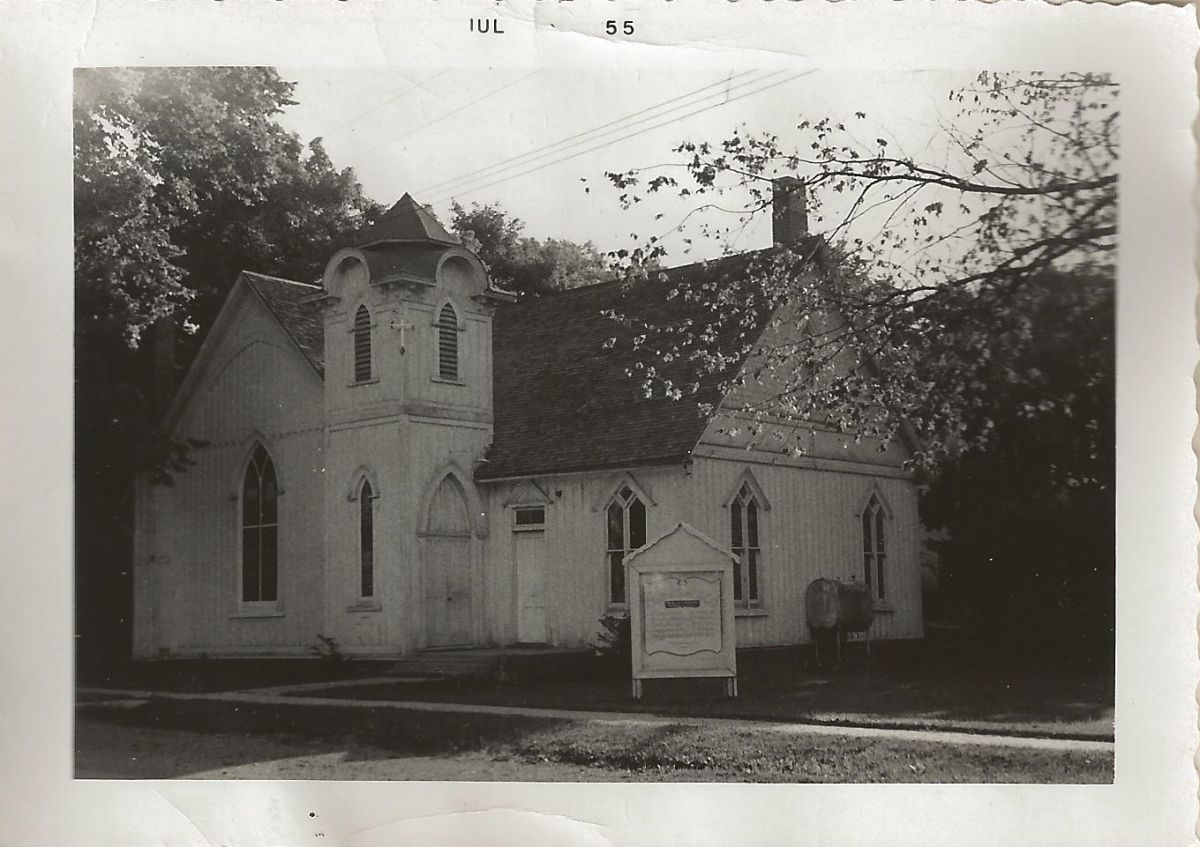 Church of God, 1955. Built 1877 by McLean’s Congregational Society. Mary Moreland, first woman ordained a US Congregational minister, served 1895–1904. The Church of God purchased it in 1923. Now a home, it still stands at the corner of Spencer & Clinton.
Church of God, 1955. Built 1877 by McLean’s Congregational Society. Mary Moreland, first woman ordained a US Congregational minister, served 1895–1904. The Church of God purchased it in 1923. Now a home, it still stands at the corner of Spencer & Clinton.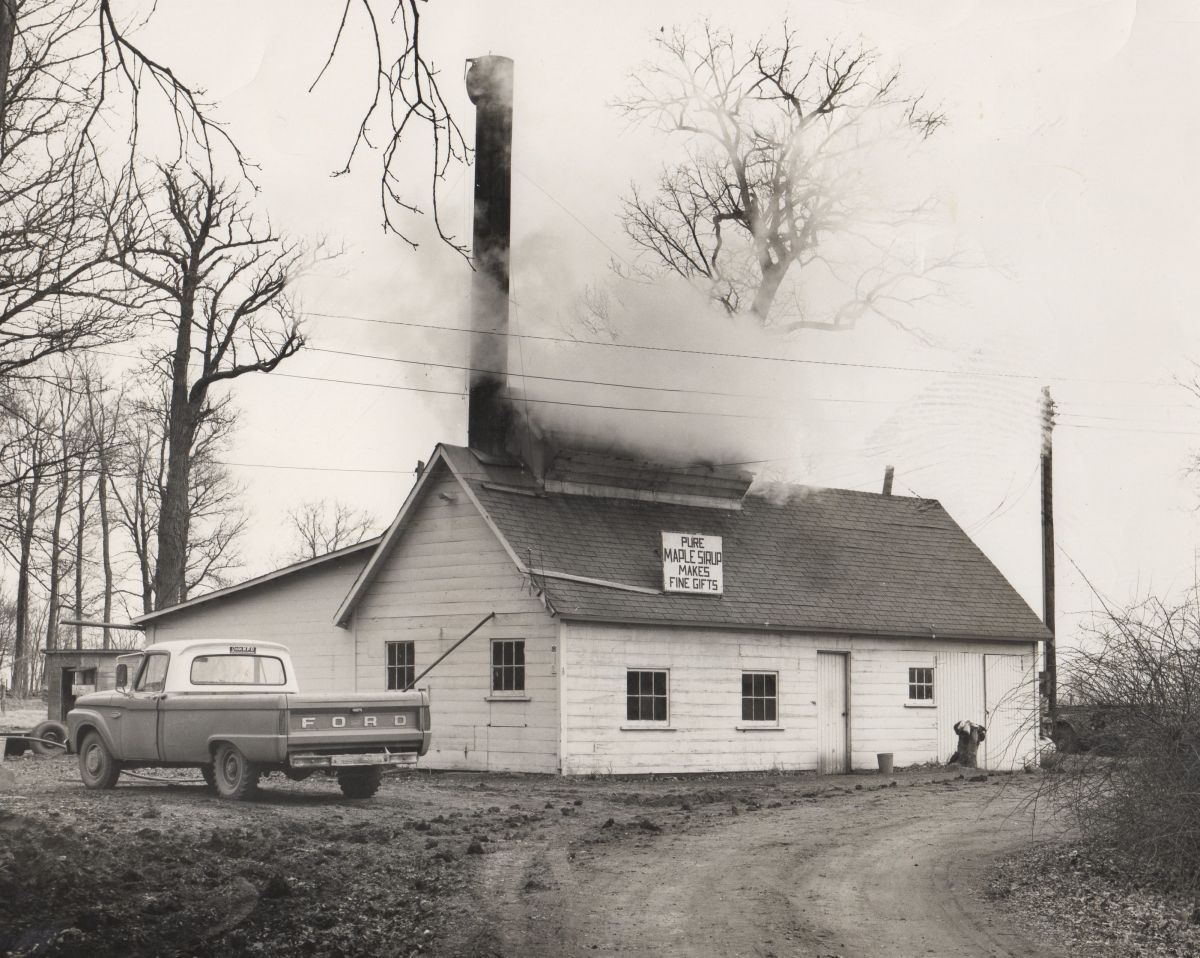 Funks Grove Pure Maple Sirup, 1967. This sugarhouse (built 1930) was in use until 1988 and had cooking, evaporator, and storage rooms, but no sales room. Instead, sirup was sold from the enclosed porch on Stephen & Glaida Funk’s home on the same property.
Funks Grove Pure Maple Sirup, 1967. This sugarhouse (built 1930) was in use until 1988 and had cooking, evaporator, and storage rooms, but no sales room. Instead, sirup was sold from the enclosed porch on Stephen & Glaida Funk’s home on the same property.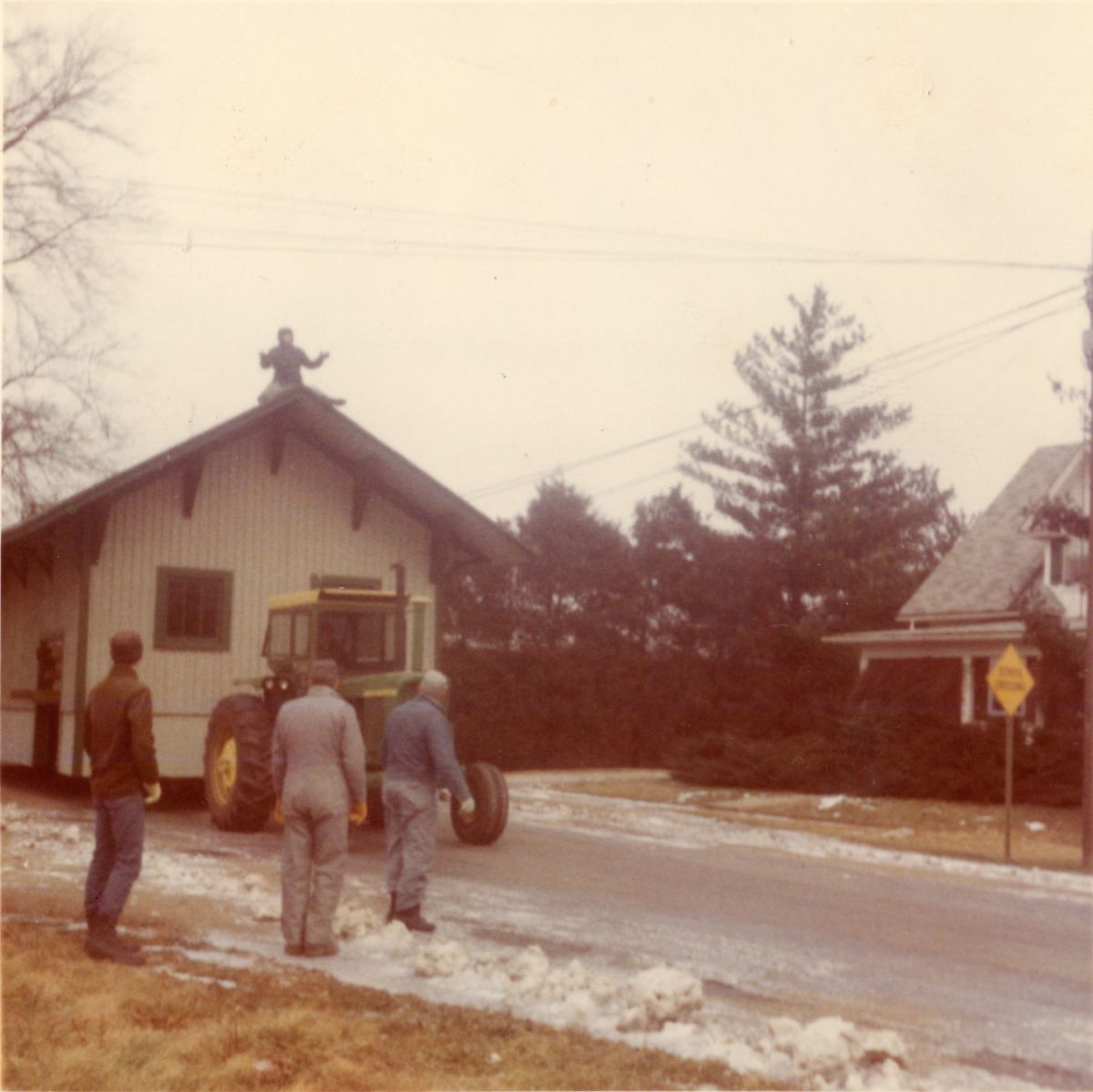 Moving the McLean Depot to its current location across from the Dixie on Hwy 136, 1971. Here it once housed antique stores and now boasts a Train Shop, where owner Tom Ludlam shares this piece of McLean history with travelers from all over the world.
Moving the McLean Depot to its current location across from the Dixie on Hwy 136, 1971. Here it once housed antique stores and now boasts a Train Shop, where owner Tom Ludlam shares this piece of McLean history with travelers from all over the world.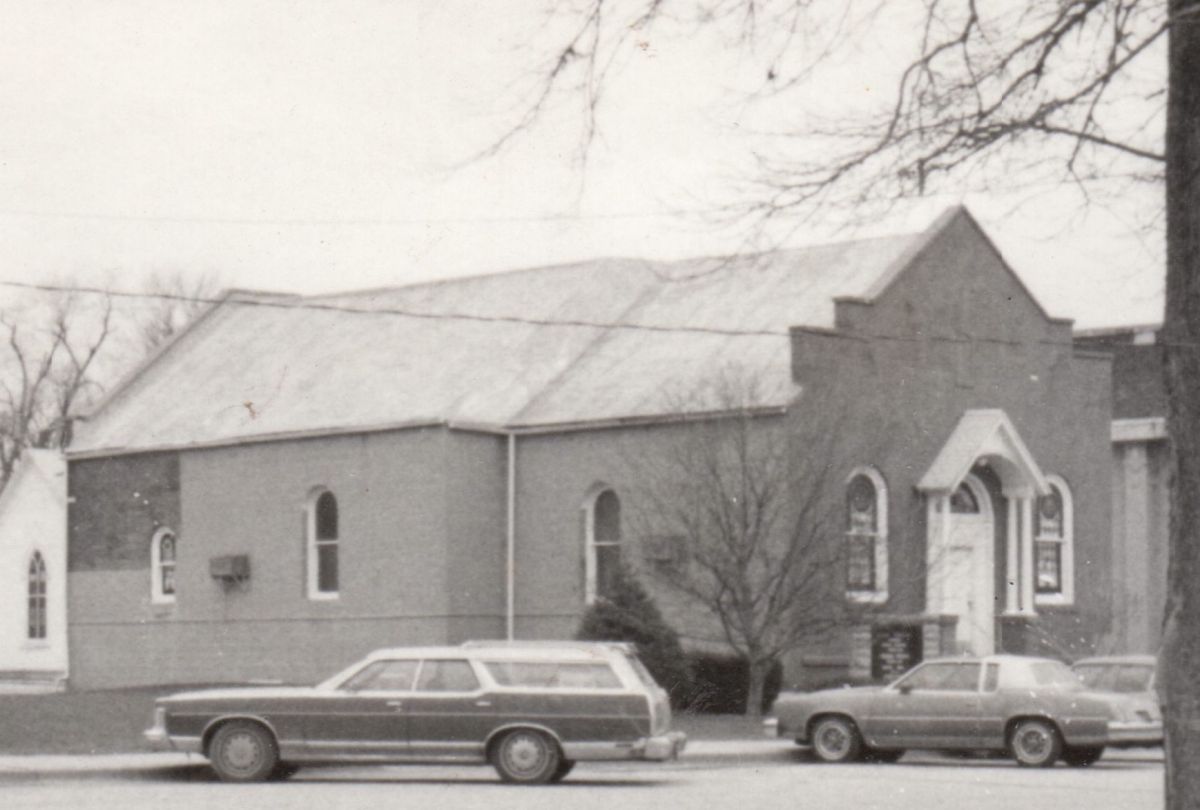 McLean Christian Church, circa 1975. Organized in 1903, the McLean Christian Church held services in the auditorium of the Community Hall until 1905, when this church was erected across the street. The church was rebuilt in the same location in 1984.
McLean Christian Church, circa 1975. Organized in 1903, the McLean Christian Church held services in the auditorium of the Community Hall until 1905, when this church was erected across the street. The church was rebuilt in the same location in 1984.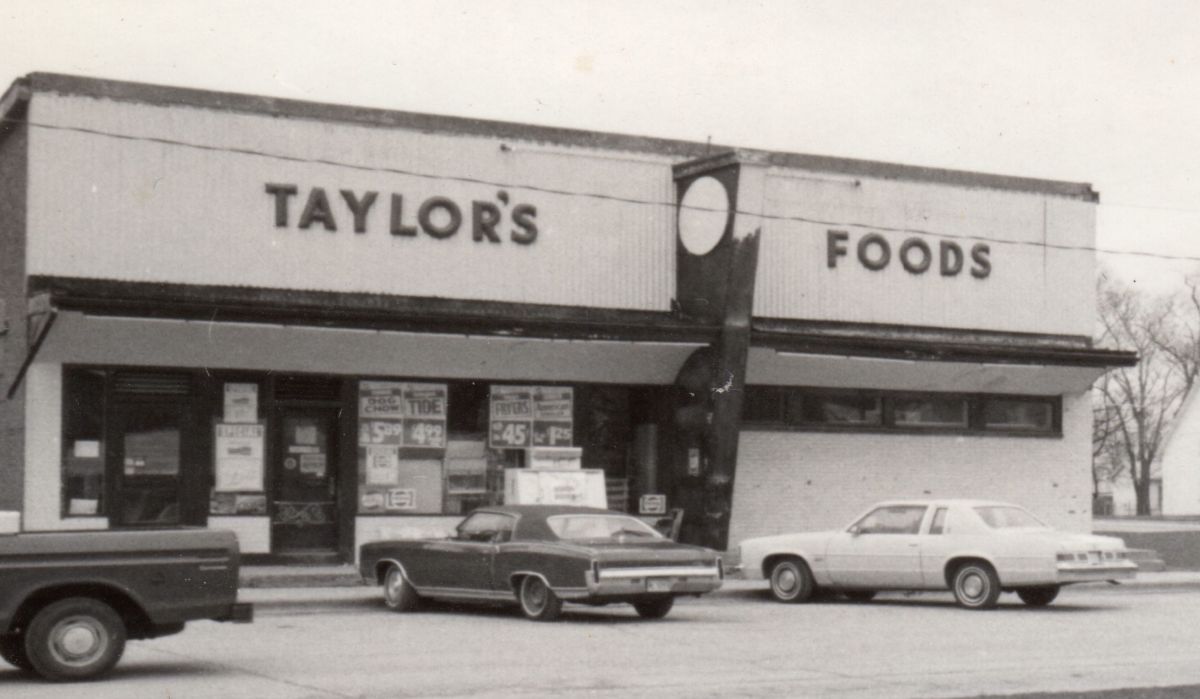 Taylor’s Foods, north side of square (next to bank building), circa 1975. In 1946 W. G. Taylor opened a hardware, appliance, and dry goods store here; in 1953 he moved this to the basement and his grocery store from across the square to the first floor.
Taylor’s Foods, north side of square (next to bank building), circa 1975. In 1946 W. G. Taylor opened a hardware, appliance, and dry goods store here; in 1953 he moved this to the basement and his grocery store from across the square to the first floor.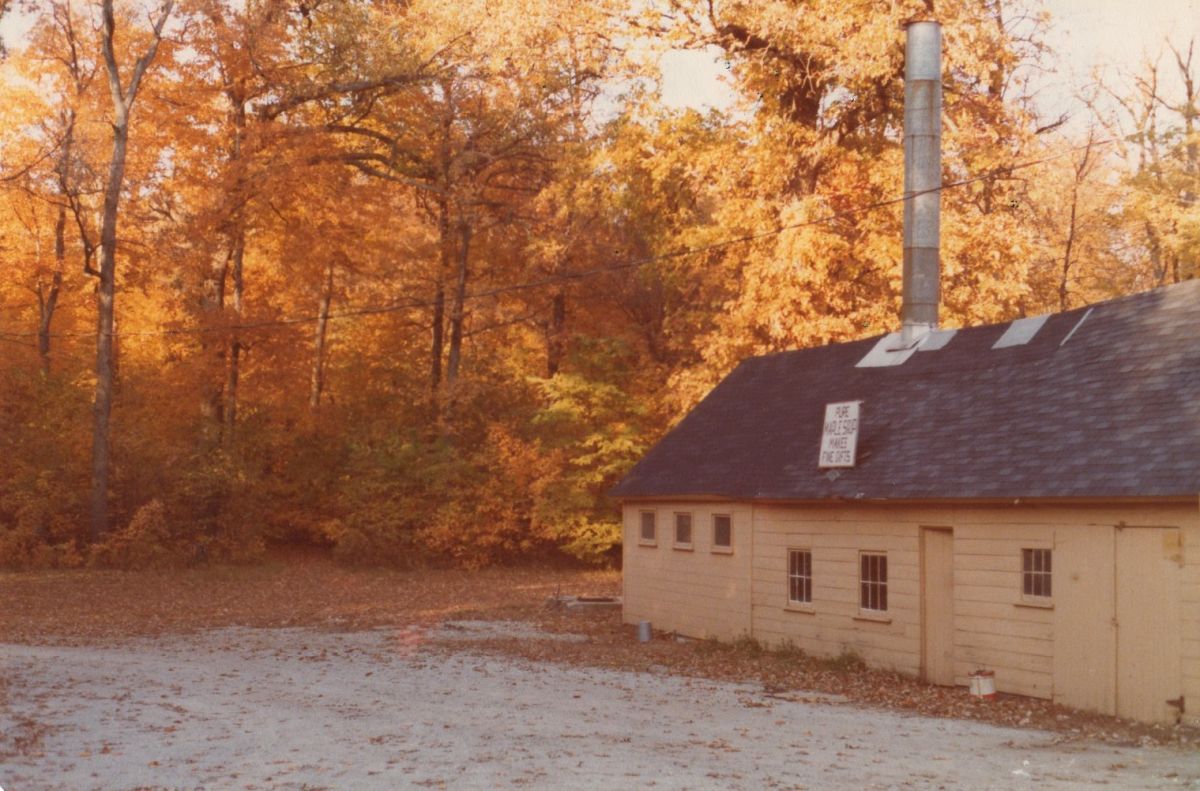 Funks Grove Pure Maple Sirup, 1978. This is the sugarhouse built in 1930, with a newer cooking room visible at the end of the building. The current sugarhouse, built in 1988, used this cooking room until it was replaced with a commercial kitchen in 2017.
Funks Grove Pure Maple Sirup, 1978. This is the sugarhouse built in 1930, with a newer cooking room visible at the end of the building. The current sugarhouse, built in 1988, used this cooking room until it was replaced with a commercial kitchen in 2017.  Dixie, circa 1970s–80s. “Bigger and better” Dixie, built in 1966–67, after fire destroyed the original in 1965. In the meantime, a steel machine shed was quickly erected so the beloved Truckers’ Home could continue serving customers during construction.
Dixie, circa 1970s–80s. “Bigger and better” Dixie, built in 1966–67, after fire destroyed the original in 1965. In the meantime, a steel machine shed was quickly erected so the beloved Truckers’ Home could continue serving customers during construction.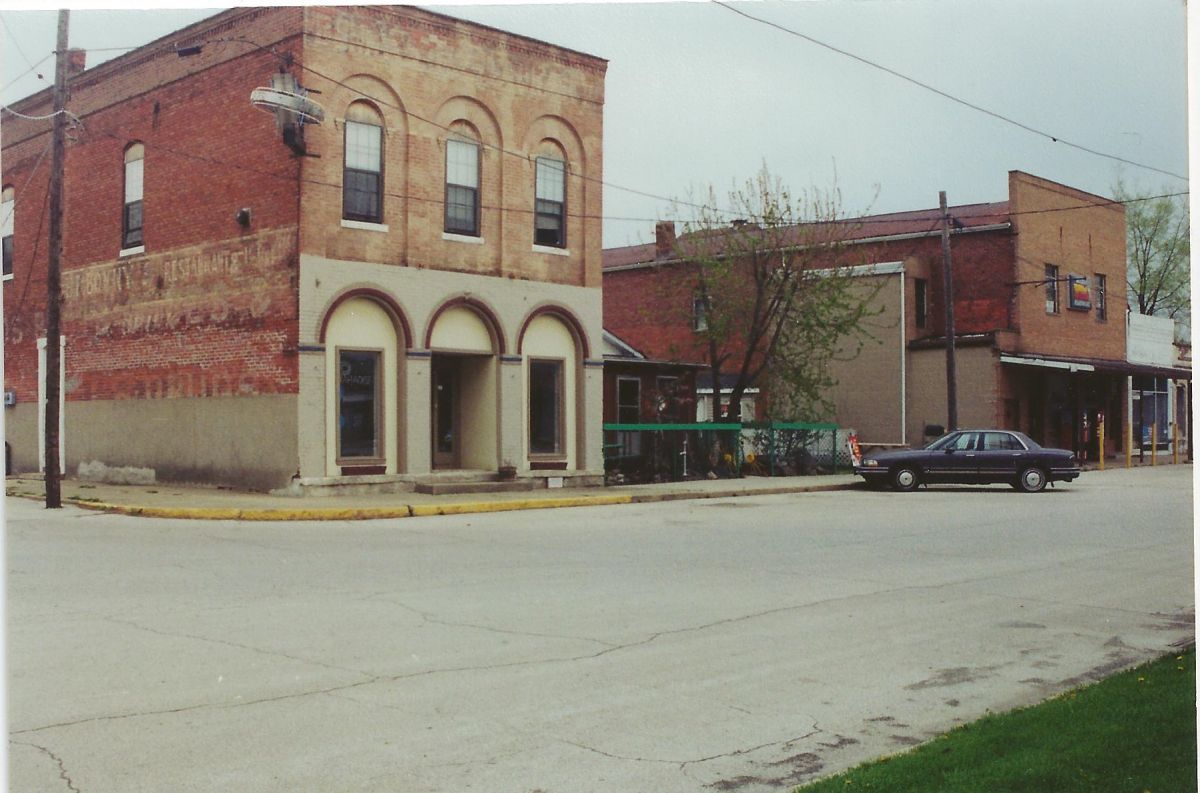 Village Square, corner of Park & Center, circa 1990s. The corner building housed E. B. Bonny Restaurant in the early 1900s, then became Sieb’s Hatchery in 1929. Traces of advertisements for both businesses can still be seen on the side of the building.
Village Square, corner of Park & Center, circa 1990s. The corner building housed E. B. Bonny Restaurant in the early 1900s, then became Sieb’s Hatchery in 1929. Traces of advertisements for both businesses can still be seen on the side of the building.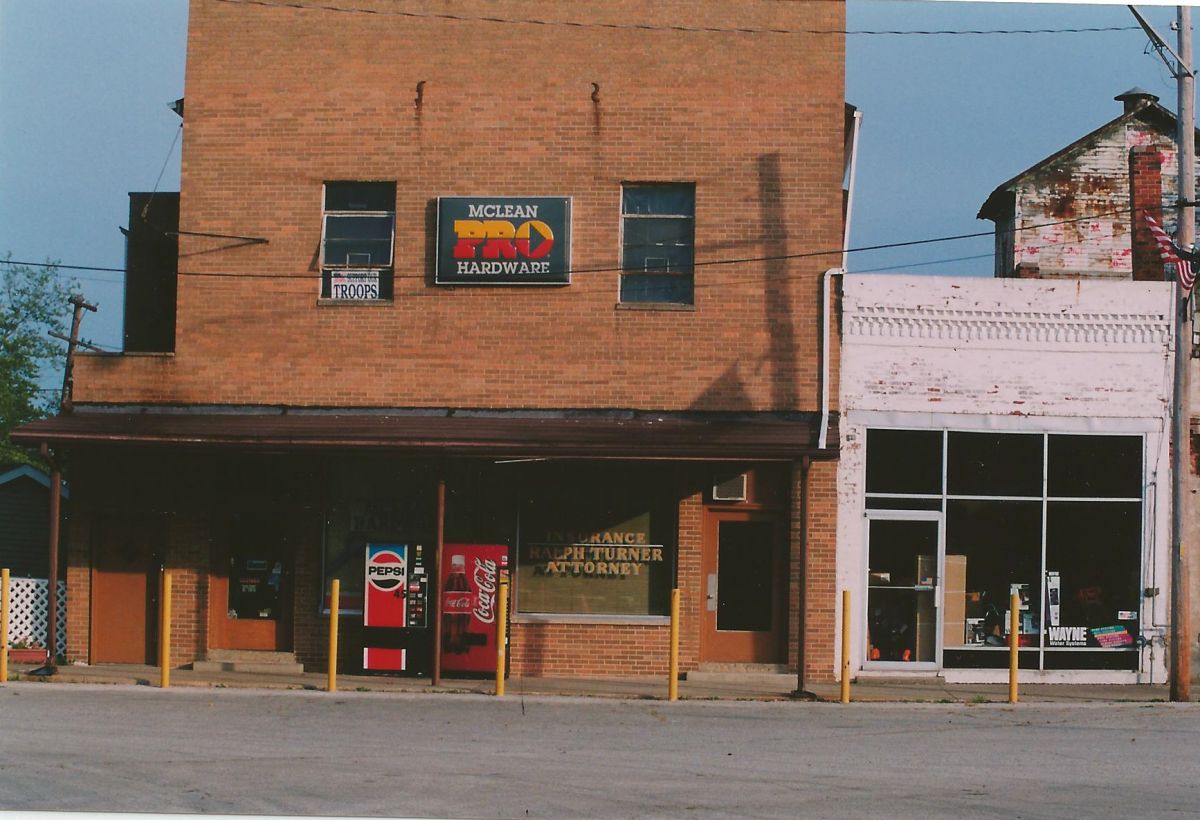 Village Square, Park St., circa 2000. Today, McLean Hardware store is open, operated by Scott & Sandy Sheldon. Attorney Ralph Turner used the center office for many years, until he passed away in 2019. The other buildings have since been demolished.
Village Square, Park St., circa 2000. Today, McLean Hardware store is open, operated by Scott & Sandy Sheldon. Attorney Ralph Turner used the center office for many years, until he passed away in 2019. The other buildings have since been demolished. 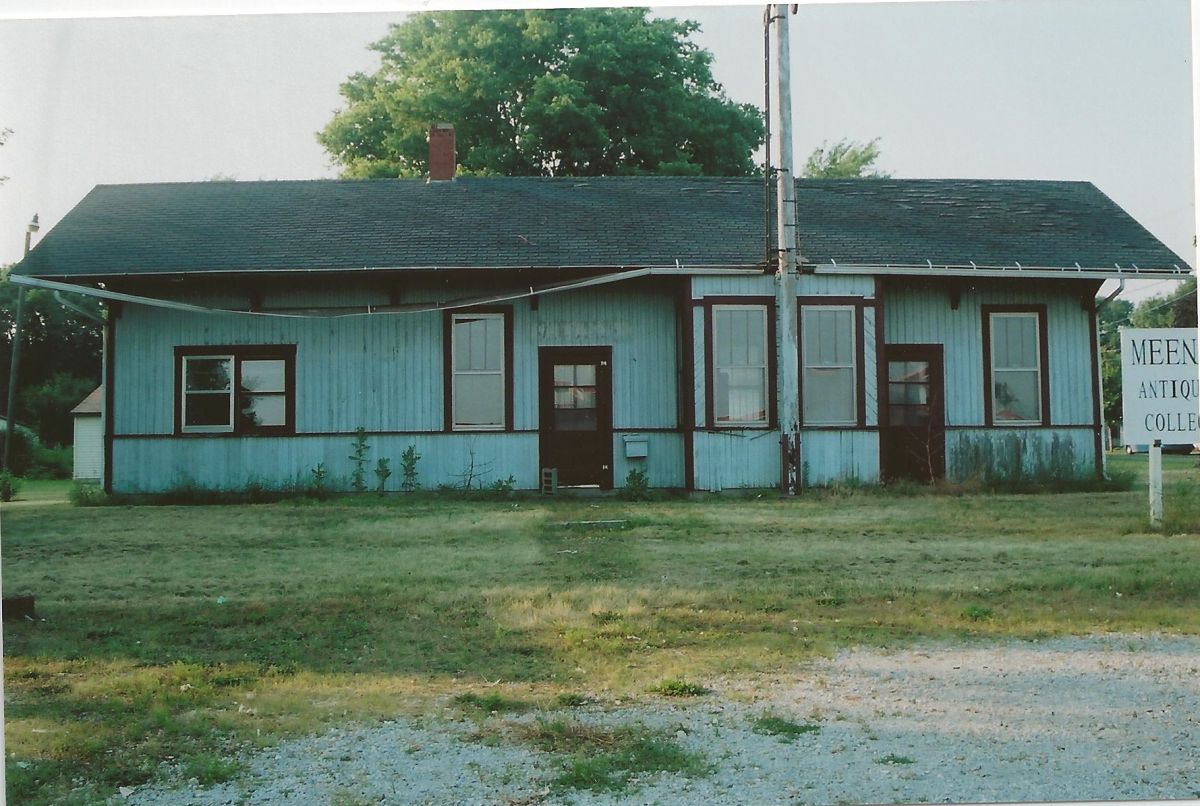 McLean Depot, 2002. The depot in place on Hwy 136. It was still being used as an antique store at this time. It was later purchased by the Village, who renovated it in 2010–11. It is now a hobby train shop and info center for Route 66 travelers.
McLean Depot, 2002. The depot in place on Hwy 136. It was still being used as an antique store at this time. It was later purchased by the Village, who renovated it in 2010–11. It is now a hobby train shop and info center for Route 66 travelers.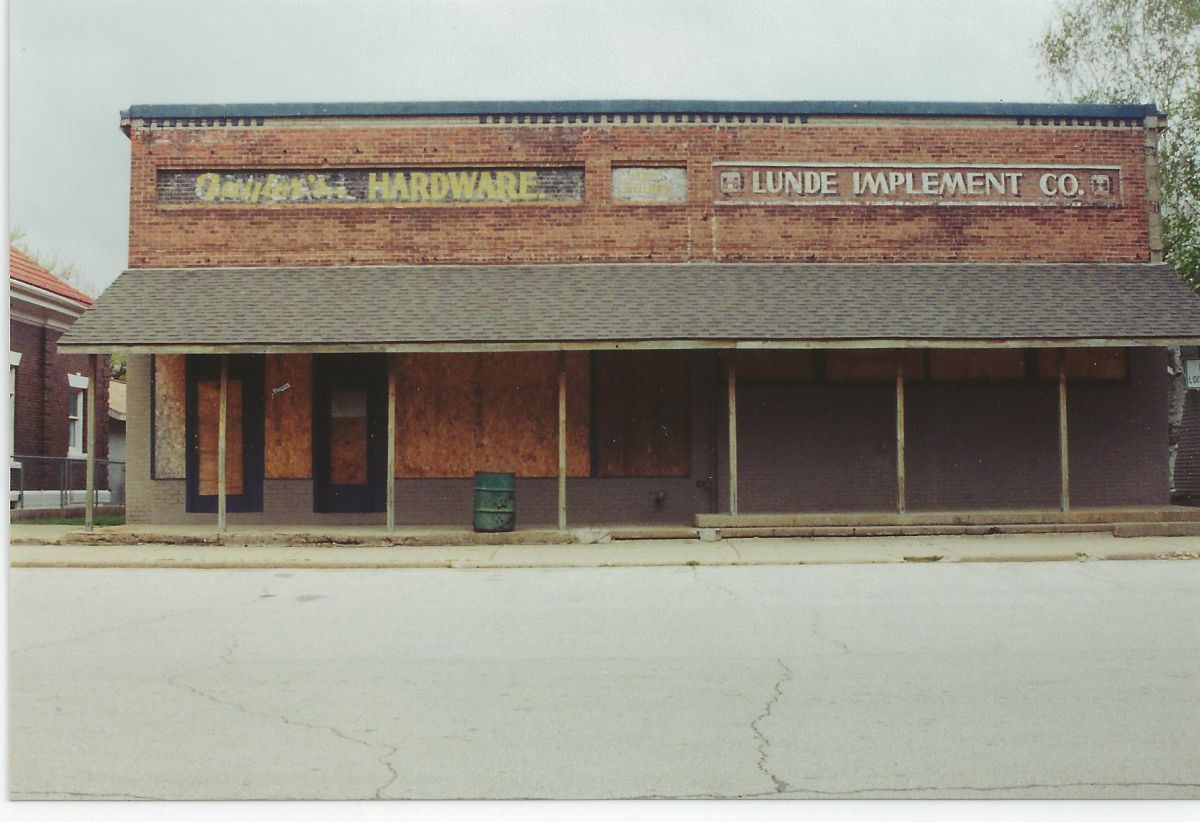 North side of Village Square, circa 2005. Signs for O. W. Earl Hardware, located here from 1941 to 1946, and Lunde Implement Co., located here from 1944 to 1964 (?), are visible. The building now serves as game storage/work space for the nearby arcades.
North side of Village Square, circa 2005. Signs for O. W. Earl Hardware, located here from 1941 to 1946, and Lunde Implement Co., located here from 1944 to 1964 (?), are visible. The building now serves as game storage/work space for the nearby arcades.